Next 5 days
- THURS 25 °C
Climatic Data
Source: National Observatory of Athens / meteo.gr
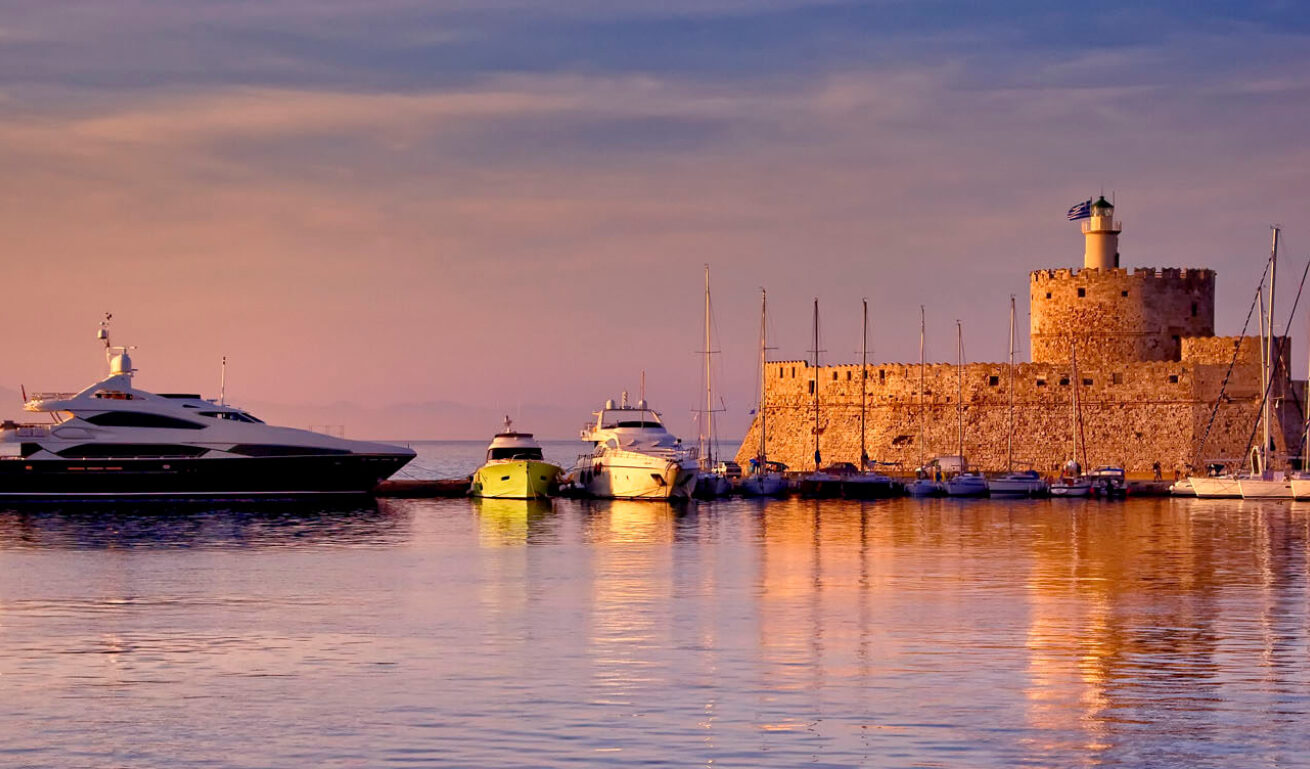
© P. Merakos

The island of vivid contrasts
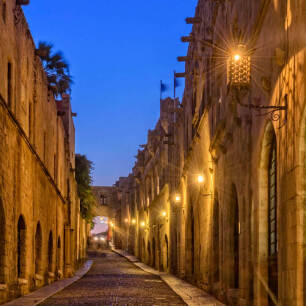
Unique Experiences

Tour the island
Filming in rhodes.
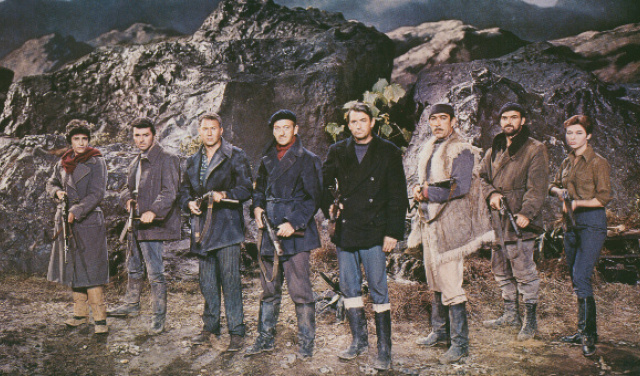
THE GUNS OF NAVARONE (1961)
This film was a major box office success and became one of the 1961 most important films. Many famous actors starred, like Gregory Peck, David Niven, Anthony Quinn, Stanley Baker, and Irene Papas.
DIRECTOR: J. LEE THOMPSON FILMING LOCATION: RHODES
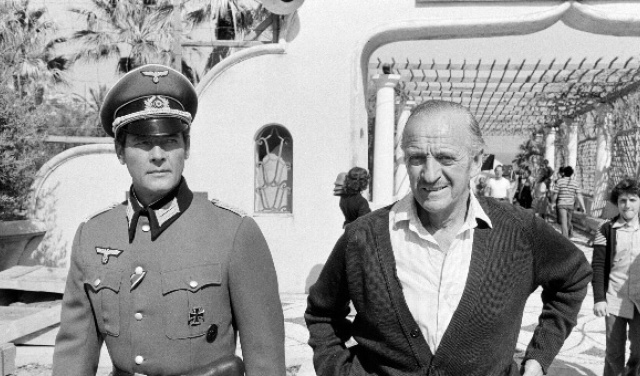
ESCAPE TO ATHENA (1979)
The movie is set during the II WW. It is an adventure war film with some comedy elements about a strong Greek resistant movement that took place on a small island. This movement prepares the landing of the Allies and plans to overtake a prisoner camp, run by an Austrian general (Roger Moore). This Austrian general loves antiques and actually has forced his prisoners to work in archaeological excavations, in exchange for a more comfortable treatment. Also starred Terry Savalas, Claudia Cardinale, and David Niven.
DIRECTOR: GEORGE COSMATOS FILMING LOCATION: RHODES, CORFU, HALKIDIKI
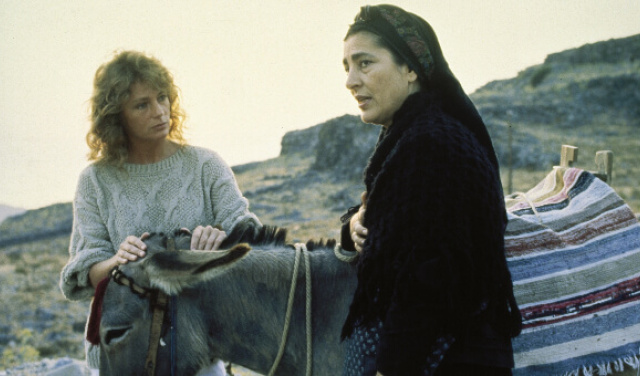
HIGH SEASON (1987)
On the island of Rhodes, an expatriate English photographer lives with her daughter. A young local wants to encourage tourism, so he commissions a sculpture of the Unknown Tourist for the town square; the sculptor he brings to Rhodes is photographer's ex-husband...
DIRECTOR: CLARE PEPLOE FILMING LOCATION: RHODES
Local Dishes

Other destinations
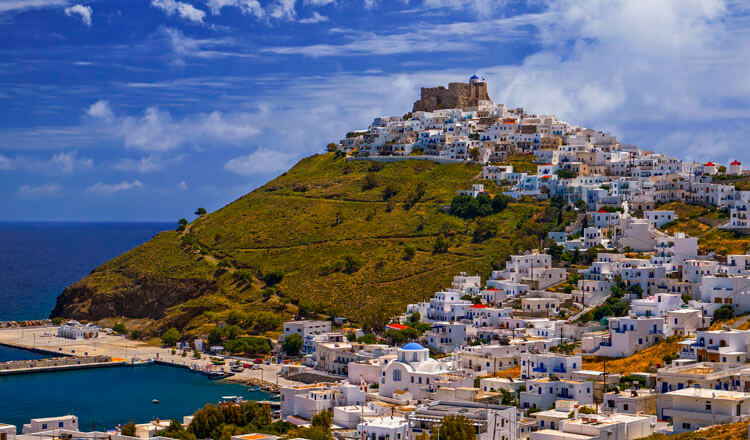
Kastellorizo
Ferry routes.

- Tourist Guide

Explore Rhodes
General information, information offices, useful phone numbers, foreign states consulates, tourist authorities, accommodation, transportation, monuments of religion, family vacation, civil weddings, walking routes, sports tourism, water sports, feasts and festivals, local products, persons with disabilities, world tourism day, awarding programme for repeaters, past years activities.
Read the pamphlet and EXPLORE_RHODES
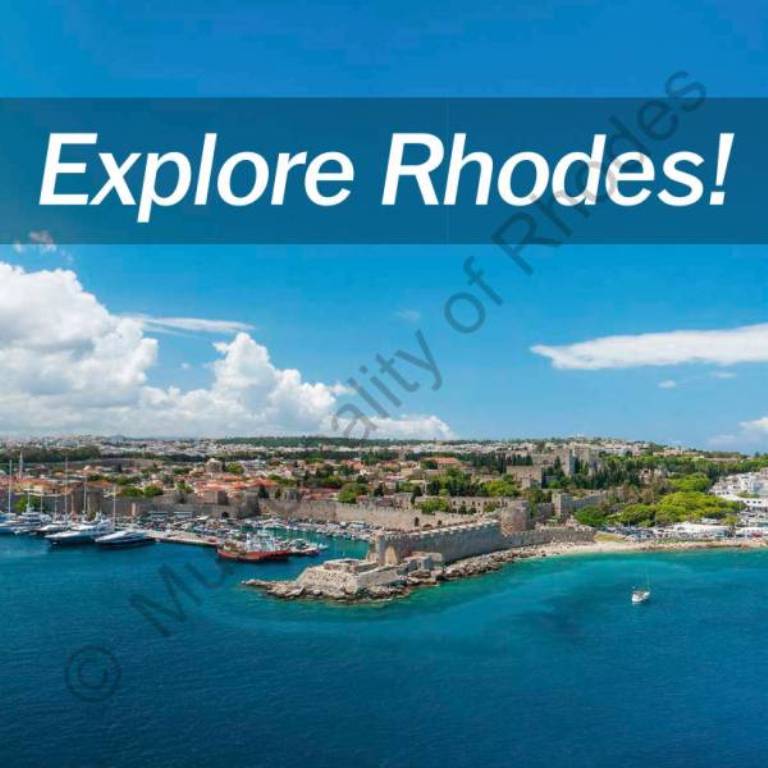
The island of Rhodes is situated in the South Aegean Sea. It is the largest island in the Dodecanese and the fourth in Greece after Crete, Evia and Lesvos (Lesbos). It has a long history, a rich natural environment, beautiful beaches and modern tourist facilities, elements that have for decades made it a one of the most popular tourist destinations both nationally and worldwide.
The island of Rhodes is oblong and has the shape of a spear edge. Located about 460 kilometers southeast of Athens, 380 km west of Cyprus and 18 km southwest of Turkey. Its length is 77 km, width 37 km and total area of 1,401 square kilometers (1,408,749 acres). It has 253 kilometers of coastline. The island can be described as mountainous with the highest mountains the Attavyros (1210 meters), the Artamytis (825 meters) and the Prophet Ilias (800 meters).
The population according to the latest census amounts to 125.113 inhabitants.
The island can be reached both by air or sea.
Rhodes has an International Airport, “Diagoras”, located in Paradisi, 15 km from Rhodes town.
The inhabitants of Rhodes speak except from the Greek language mostly English, and many of them know other languages like German,French , Italian, Spanish, Russian and others.
The official currency is the euro.
Standard Time: UTC / GMT +2 hours Summer Time: UTC / GMT +3 hours
The weather on the island is clear and sunny all year round. The maximum and minimum temperatures per month are as follow:
For more weather information please click here: www.meteo.gr
The public holidays for 2024 are:
• January 1 The New Year’s Day • January 6 The Epiphany • March 7 The National Day (The Integration of the Dodecanese to Greece)- Parade • March 18 The Beginning of the Lent • March 25 The National Day (The Annunciation)- Parade • May 1 The Labour Day • May 3 The Good Friday • May 5 The Easter- The Resurrection of Christ • June 24 The Holy Spirit • August 15 The Assumption of the Blessed Virgin Mary • October 28 National Day • November 14 The St. Constantine Hydreos- The Patron Saint of the City • December 25 The Christmas Day • December 26 The Boxing Day
- Map of the island of Rhodes
For any inquiry contact us at [email protected] or visit us in person at the one of the following locations
European Emergency Call Number 112
Ministry of Tourism-Directorate for the Dodecanese Island Rhodes-Tourist Information Office +30 22410 44335 [email protected]
Municipality of Rhodes +30 22413 61200 [email protected]
The City Of Rhodes Information Office +30 22410 35945 +30 22410 35240 [email protected]
Medieval city Office +30 22410 74313 [email protected]
Tourist Port Office +30 22410 75316 [email protected]
Lindos Tourist Information Office +30 22440 31900 +30 22443 60100
General Secretary Of Commerce (General complains, advices for reservation problems) 1520
Tourist Police +30 22410 27423 +30 22410 23329 [email protected]
Passport Control – Airport +30 22413 60364
Passport Control – Tourist Port +30 22410 24138
Police Emergency Service 100
Emergency Fire Service 199 +30 22410 43560 +30 22410 43561
Forestry Fire Service 1591
Hospital of Rhodes +30 22413 60000 www.rhodes-hospital.gr/ [email protected]
Emergency 166 (you can dial it from any card phone without using any card)
Private Hospital- Euromedica +30 22410 45000 www.euromedica-rhodes.gr [email protected]
Medical Center Krito I. Metaxa 3, Rodos 851 31 +30 22410 30020 www.krito.gr [email protected]
Traffic Police +30 22410 44131
Animal Welfare Mr. Kritikos George +30 69406 84540 [email protected]
LUCKY PAWS [email protected]
STRAY GANG [email protected]
Archaeological Service of Dodecanese – Rhodes +30 22413 65200 [email protected]
For further infomation about the Embassies or the Consulates please contact the Ministry of Foreign Affairs
1st Vas. Sofias Av.106 71 Athens, Greece +30 21036 81000 www.mfa.gr
The city and island of Rhodes offer to the visitor accommodation services affordable for anyone. In modern hotels, the visitor enjoys top-level services. As exceptional as the accommodation are the conference facilities of our city and island, which often host international political, financial and academic meetings.
Find more about your accommodation in Rhodes at the official website of Rhodes Hotel Association: www.exr.gr
- Ship Connections
- Airlines Domestic Connections
PORT AUTHORITY
[email protected] | +30 22410 22220 | +30 22410 28666 | +30 22410 28888
Mandraki Marina
Bays Worth Visiting:
- Antony Quinn Bay- Ladiko
- Areas of Natural Beauty
Time Schedule – Archaeological Sites
The Medieval Town of Rhodes
Generally the Medieval Town of Rhodes preserves the architecture of the knightly era (1310- 1522 A.D.). The arrival of St. John’s Knights from Jerusalem to Rhodes in 1310 A.D. was followed by the induction of western elements in local art and the architecture. Especially in ecclesiastical architecture two tensions appear.
The first one concerns the Roman Catholic churches where the gothic architecture applied as it was configured in the Holy Land and in Cyprus, where the Knights were prior to their arrival in Rhodes. That style evolved in Rhodes. It lent and borrowed many elements from the local architecture and the byzantine tradition. It adjusted to the local materials and the Rhodian limestone, which was greatly exploited, creating unique artifacts. The regenerative art of the West made a huge impact on the local architecture and art in general on the island.
The second ecclesiastical architectural tension concerns the Greek Orthodox churches that follow the byzantine tradition. Only after the Knights’ departure from the island, the orthodox churches imitate the gothic style with crossed arches. That new architecture, mostly known as the “Dodecanese type”, is found outside the castle walls where the Christians were located during the ottoman period (1523- 1912 A.D.).
A. Orthodox churches within the Medieval Town that officiate as parishes.
1. agios fanourios (saint fanourios).
Is located at the namesake street in the Medieval Town of Rhodes. It was built in the 13th century A.D. It’s cross shaped and the interior is adorned with wonderful frescos. It officiated as a mesgit (small mosque) during the ottoman occupation. There is no known testimony for its name before the ottoman period. The interior was preserved in the 20’s by the Italian Archaeological Service. After the World War II, Greeks took over the church. In 1946 the church was inaugurated and dedicated to Agios Fanourios.
This churchofficiates today. The worship of Agios Fanourios seems to have started from Rhodes and then expanded initially to Crete and then to the rest of the country. Different sources cite that, while workers were digging outside the southern walls to collect building materials, they uncovered the ruins of a church. Among other things, an icon was found depicting Agios Fanourios wearing a military uniform and surrounded by scenes of his martyrdom. Obviously that icon was part of a fresco. Agios Fanourios’ first miracle was the liberation of three Cretan priests from pirates while transferring a copy of the archetypal icon to Crete.
Christiansshow their great respect for Agios Fanourios by baking a traditional cake dedicated to him, the “Fanouropita”. The cake is usually small in size and round and is made of flour, sugar, cinnamon, oil, sweet red wine and orange juice. All ingredients are mixed together and placed in a round girdle, baked at medium temperature. With the pie, Christians ask Agios Fanourios for his help in recovering a lost object, a lost case, health problems etc.
According to tradition, Agios Fanourios mother was a sinner. She was cruel to poor people. That’s the reason, according to the myth, she went to hell. Her son tried to save her but she was too evil. Worshipers bake these cakes and ask God to Forgive her. After the cake gets blessed, it is shared around the neighborhood. Agios Fanourios church celebrates on August 27th.
2. Agios Panteleimon church (Saint Panteleimon)
The church is located on the northeast end of the Medieval Town,near Agia Ekaterini’s Gate. It was built after the first siege from the Ottomans on July 27th (day of the churches celebration) 1480 A.D. It seems that this church was not turned into a mosque during the ottoman period.
According to Allert Gabriel’s narrations, who visited the island of Rhodes in 1923, the church was being used as a residence by Jewish families. Later on, unknown exactly when, the Italians repaired the building and used it as a customs office. Later on, the British used it as a police station. After the World War II it was a shelter for refugees.
During one of his visits, the Metropolitan bishop of Rhodes realized that the shelter was actually an old temple. In cooperation with the Archaeological Service, he started the restoration of the church, which was consecrated on April 25th 1948 A.D. and officiates till today.
B. Churches that were not turned into mosques by the Ottomans.
It seems that these churches were not used as mosques most probably because they were destroyed during the second siege of Rhodes in 1522 A.D. by the Ottomans.
1. Panagia tou Bourgou (Virgin Mary of Burgos)
2. panagia tis nikis (virgin mary of victory).
The archaeologists originally believed that it was located by Agia Eikaterini’s Gate. The result of an excavation at a nearby unidentified church on Kisthiniou street, created doubts on which of the two churches is the Catholic church of Panagia tis Nikis. It was built by the Grand Master Pierre d’ Aubusson in the 15th century and was destroyed by the second ottoman siege in 1522 A.D. This church accommodated the Franciscan order. Along with the Augustinian order, they were the most important catholic monasteries on Rhodes Island. The Franciscans built the new Catholic church (mostly known as Sancta Maria) in 1743 A.D. in the district of Neohori.
C. Churches that were turned into mosques
All churches inside the Medieval Town, after the ottoman occupation in 1522 A.D., were turned into mosques. From all 34 or 35 churches only some of them can be identified with certainty and they are all of special interest. After the interventions by the Archaeological Service, those churches were restored. A visitor can still see the traces left behind by the passage of time and by their transformation into mosques, mesgits (little mosques) and even residencies.
Observing these monuments, one comes to the conclusion that the island of Rhodes favored due to its location and for the same reason desired, has known greatnesses and misfortunes, bitterness and elations. At the end, what’s left is the Rhodian sun that never stopped giving light to humanity and the universal character of this glorious island.
Some of these monuments are:
1. Panagia tou Kastrou (Virgin Mary of the Castle)
2. agia triada church on ippoton street ( khan zade mescidi).
It was established by the order Knights of Saint John and therefore it was dedicated to the catholic denomination. In its original form it was a one-room church covered by a unique arch. During the ottoman siege it was transformed into a mosque. An ellipsoid dome that covers the monument today is the only thing left from this last transformation.
From the interior frescos few remains are preserved today due to the profound intervention by the Italians. On the archway, one can see the rare pictorial theme of God’s Throne. The fresco depicts God on his throne, holding his crucified son in His arms. This is a western type variation of Agia Triada’s (Holy Trinity) theme.
The name of the church was given due to this theme. The fresco also depicts Virgin Mary, Saint John the Baptist and some Bishops. It is dated from the end of the 15th century and the beginning of the 16th.
The ruins are located across from Grand Master’s Palace. On December 27th 1522 A.D., the day the Knights officially handed over the island’s command to the ottomans, sultan Suleiman the Magnificent prayed at this church which later on became the most important Muslim temple, the Great Mosque of Rhodes.
The temple was a three-aisled gothic basilica with a wooden roof. The temple was destroyed by an explosion. This was caused by lightening hitting a barrel of gunpowder forgotten in the basement. The Metropolitan church of Virgin Mary’s Annunciation was built based on the patterns of this temple.
4. Agios Georgios Monastery (Chourmali mosque)
At the eastern part of the yard there’s an atrium dated from the 5th or 6th century. That rare type – in the Hellenic region -, the construction’s high quality and the morphological elements of the local technique, are the elements that give great value to the monument. This monument is a sample of the Rhodian Knightly architecture. During restoration work it was revealed that the entrance’s doorstep was an architectural part showing Virgin Mary praying between two angels. Today the finding is exposed inside the church.
During the ottoman occupation the monastery was turned into a seminary (Medrese) given the name “Chourmali” and the temple into a mosque. Later it was operated as a girl’s school by the Ottomans and on the 20th century it was transformed into houses for poor families.
The monastery was restored by the Italian Archaeological Service during the Italian occupation. The monastery received an honorary distinction from Europa Nostra in 2006.
5. The Holy Apostles and Old Mess complex (Imaret)
It’s located on the southern part of Socratous street, right across from Suleiman’s Mosque, inside the Medieval Town of Rhodes. A three-aisled church (14-15th century), dedicated to the Catholic denomination, was located in the area of the Old Mess. It was probably destroyed during the ottomans’ first siege in 1480 A.D. and then by an earthquake in 1481. The only remains from the original church are a stone column of the south colonnade and a column’s base of the north colonnade.
Between 1480 and 1522 a small one-room church was built over the ruins and in 1522 sultan Suleiman the Magnificent founded a poor house (Imaret). New buildings were added used as warehouses or kitchens. Conversions were made to the church and the altar’s arch was turned into an oven. Restoration work was held from 1986 till 1999. Today the complex is used for art exhibitions, playground and restrooms.
6. Agios Nikolaos or Saint Augustine’s Monastery
It was recently discovered and is located southwest of Omiros street. It can also be reached by Andronikos Street. It consists of the church and a yard on the north side, the main area of the temple on the northeast side and the cells on the east side. It is obvious that the monastery’s yard is located where today the “Medieval Town Theater” is found. This monastery, from the order of Augustines, was one of the most important Catholic churches on Rhodes.
Recent excavations brought to light an older one-room church of the 14th century which was probably the reason why Dragonino Clavelli added a chapel at the north side in the 15th century dedicated to Agios Nikolaos and was used as a burial area for his family.
During World War II, a bomb destroyed half of the church and its surrounding area. After its restoration, the church was used as a private home up until recently when the Archaeological Service of Rhodes took exclusive ownership of the building.
7. Agia Kyriaki (Barasani mesgit)
8. agia ekaterini (ilk michrab).
It is located on the south part of the Jewish district inside the Medieval Town. It’s a three-aisled basilica type church, built in the 14th century. An examination of the building and the fresco phases suggest that it used to be a one-room church and more aisles or chapels were added through the passage of time.
Soon after the Ottomans invaded the city, the church was turned into a mosque given the name Ilk Michrab (first praying cavity). It is believed that this one was the first Christian church that became a mosque in 1522. The monument suffered severe damages from a bombing in World War II, it was roughly repaired by the locals and was totally restored by the Archaeological Service of Rhodes.
9. Agia Triada in the Jewish district (Holy Trinity) – Dolapli Mosque
Besides turning Christian churches into mosques, the ottomans also built some new ones that are considered excellent samples of the Islamic architecture such as:
1. Ibrahim Pasa Mosque
It’s in Platonos square near the bazaar in Medieval Town. The marble sign on the main entrance informs us that it was built in 1540- 1541 A.D. by Suleiman. Therefore, this mosque is the oldest one on Rhodes island. It consists of a large square building, with 12- side dome and two consecutive porches on the north side. The minaret is located on the northwest side of the mosque and it has an octagonal fountain.
2. Sultan Mustafa’s Mosque
In Arionos square, in the courtyard of Suleiman’s Turkish baths. According to a marble sign it was built in 1764- 1765 by sultan Mustafa. It is a very tall square building with a dome in the middle, navicular arches on three sides and two hemispherical arches on the north corners. The pyramidal exterior shape of the building is very impressive with its octagonal fountain in front of the mosque. Today the Muslim community of Rhodes still uses this mosque for ceremonies.
3. Suleiman’s Mosque
4. mehmet aga mosque.
It is located on the first floor of a building on Socratous street. It’s oblique position in comparison to Socratous st. (facing towards Mecca) led to the angular projection of the mosque which is supported by a column that can be seen in the middle of the street.
The wooden minaret has a roofed balcony that ends up to a stoned stairway. The view is exceptional from the top. The exterior look of the building was based on the same architecture as the byzantine mansions built in the 18th century.
It suffered severe damages in 1863 from earthquakes and was repaired in 1875. New repairs were made in 1948 after the 1944 bombings. These last repairs also altered the interior decorations. The last restorations took place in 2004.
5. The Sindrivan Mosque
Can be found on a sidestreet by Socratous street, near Ippocratous street and “Thalassini” Gate. It is built on the first floor of a building above shops.
During the Knightly period, St. Sebastian’s church was located in that area. Sinan Beis built the mosque on the ground floor which was later burnt. In 1888 a new mosque was built on the first floor. It has an octagonal floor plan and is covered with a dome. A small terrace created above the balcony was used as a minaret. The mosque was restored in 2004.
6. Retzep Pasa Mosque
Can be found on Dorieos square. It was built in 1588 and is the most important ottoman building. Persian ceramics can still be seen on the exterior. Its interior is luxurious with Quran verses on the walls decorated with enamel. The founder’s sarcophagus is on the eastern side of the mosque. Unfortunately this mosque cannot be visited due to maintenance in progress.
7. Murat Reis Mosque (outside the Medieval Town)
It’s right across from the Prefecture building. It was named after Suleiman’s admiral who was killed during the town’s siege and he was buried there in a tourbe, a type of a round mausoleum.Today it is still a mosque and is used as a cemetery. Many famous people were buried there while they were exiled in Rhodes.
E. The Synagogue Shalom
The interior follows the traditional Sephardic style and the “Teva” (altar) is in the center facing southeast towards Jerusalem. On the east side of the yard there’s a sign where a fountain used to be with an inscription “Kislev 5338” (1577 A.D.).
The city of Rhodes outside the walls
After the ottoman occupation in 1522, the Christians settled outside the walls in neighborhoods called “ Marasia ”. The areas that were granted to them were actually gardens and destroyed mansions and churches. Each neighborhood had its own church which it was named after. These neighborhoods are:
- Agii Anargyri (St. Kosmas and Damian)
- Agios Ioannis
- Agia Anastasia
- the Mitropolis
- Agios Georgios o Kato
- Agios Georgios o Ano
- Agios Nikolaos
A new neighborhood was built later (Niochori) with its church, “The Presentaion of the Virgin Mary”.
In the 18th century the Christians were given permission to build new churches. That’s when a new architecture style appears that can only be found in the Dodecanese islands and the southeast coastline of Asia Minor. The type was named “Dodecanese type basilica” and it imitates the gothic domes of the Knights.
1. Isodia tis Theotokou (The Presentation of the Virgin Mary) church in Niochori
It is on Mandilara street. It was built in 1719 and is an example of the Dodecanese type basilica. The church celebrates on November 21st. It also celebrates on November 14th as the church is also associated with the patron saint of Rhodes Town, Agios Constantinos o Ydreos.
2. Evangelismos tis Theotokou (The Annunciation of the Virgin Mary) church
The temple remains immutable on the outside while the interior was adjusted to the needs of the Orthodox denomination in 1947. The frescos were made by the byzantine hagiographer Fotis Kontoglou and his two assistants Ioannis Terzis and Pantelis Odambasis (1951- 1961 A.D.).
3. Panagia tis Nikis, also known as Sancta MariaThe church
It is located in the central district of Niochori. The complex includes the monastery of the Franciscans of the Custody of the Holy Land who do pastoral work on the island. The monastery also has a guesthouse. The volunteers there come from different countries offer their assistance to those in need.
During the Ottoman siege in 1522 A.D., the church – located within the walls of the Medieval Town– was destroyed and the Franciscans left the island along with the Knights of St. John.
In 1719 the Apostolic Prefecture of the Franciscans of Constantinople re-established its mission in Rhodes and in 1743 a new church was built “Panagia tis Nikis”, mostly known as Sancta Maria. The new church was enlarged in 1851 and soon became the main Catholic church in Rhodes. Holy Mass is celebrated every day in various languages and the community often gathers there, particularly in St. Claire’s Hall, which was recently renovated by the parish priest with the help of friends and volunteers.
On the left side of the church, you can visit St. Francis Nativity at Christmas time. Local people and tourists from all over the island come to admire it.
4. Church of St. Francis of Assisi
It is next to the Athanasious Gate and is the official Latin Rite Parish church of Rhodes. On September 20th 1936, in the presence of the Archbishop and the Italian Governor Lago, the foundation stone of the church was laid in place.
The church, planned by architecture Bernabiti and built by engineer Vellini, was completed in 1939. This church is larger than Sancta Maria and it became the Parish church of the Franciscan Mission in Rhodes which at the time hosted many catholics.
On Sundays and holidays, Holy Mass is celebrated in Greel. Thanks to volunteers, the faithful can follow Mass in their own language through brochures with the readings translated in 12 languages. After each Mass, Father Luke and his parishioners gather in the hall behind the church or in the garden for a moment of celebration. Some of the women take turns baking traditional cakes of their countries to offer with coffee.
The church also hosts sacred music concerts. The first one was by the Italian organ player Stefano Pellini. The church was designed with wonderful acoustics and the sound starting from the altar goes to the end of the church and vice versa.
Religious tours on the island
There are 45 villages on the island of Rhodes. Every village, besides its white houses, has its main church with elaborated woodcut icon screens and remarkable icons of the byzantine and post-byzantine period. Many chapels can also be found all over the island.
We suggest that you take time to visit some of them, attend festivals or masses on their celebration day. Make sure to confirm the dates before visiting because the festivals sometimes get transferred to the following weekend. The villagers with these festivals try to maintain their tradition creating in this way a religious culture.
Religious tours on the island’s west side
On the main road from Rhodes city to Ialisos, next to “Kritika” district and between large hotels, is the church of Panagia Faneromeni. On the same road and on the left side, among a green landscape, the monastery of Three (Archangels) stands. Those two are samples of the area’s art and tradition.
1. Panagia Filerimou
The Acropolis of Ialisos and the ancient temple of Athena Poliados, who, in the 5th century A.D., became a Christian three-aisled basilica, were at the same location. The only remain of this temple is a cross-shaped font. Passing through the eastern gate, a wide stone staircase, with tall cypress trees right and left, leads us to the monastery of Panagia Filerimou dedicated to Zoodochos Pigi (Life-Giving Source).
The church complex was built by the Knights over an older Byzantine church and was rebuilt in its present form by Italian archaeologists. Right next to the font is the restored stone Gothic church.
To the left of the main entrance of the site at a lower level of the monastery there is a small one-room underground Byzantine church of Agios Georgios tou Hostou, pre-knight era, with rare frescoes depicting the knights and dating from the 14th-15th century.
Opposite the entrance of the site and outside the fence begins the so-called Calvary, a paved corridor with twelve engravings on one side, standing on pedestals, which represent the Passion of Christ. The path ends in a cross of 17,80 meters tall. Inside, staircase leads to the top of the cross offering a breathtaking panoramic view. A few steps down the hillside, is a partially restored Doric fountain with six Doric columns and an equal number of columns in the interior (4th century B.C.).
The icon of the Virgin Mary of Filerimos is one of the most important Christian relics. The story of the icon seems to start from the 11th century A.D. Mary’s face was painted on canvas, which then was applied to the wood surface. Many believe that the icon comes from Jerusalem. Some historians argue that members of the Order of St. John brought it to Rhodes to this location from which it got its name. Other historians say that the Order of St. John found it on the island after its conquest in the year 1310, and that the residents had already established Virgin Mary as their protector. The icon from 1200 to 1480 A.D. was located on the hill of Filerimos.
The year 1480 A.D. during the first Ottoman siege, the icon was temporarily transferred to the city of Rhodes and on the ramparts to inspire the army. From 1490 until 1523 A.D., the icon moved several times in the castle of the Knights due to the reconstruction of the temple on Filerimos hill, after the 1480 A.D. invasion and earthquakes. The last year, 1522 A.D., the icon moved back to the city of Rhodes during the second Ottoman siege, and was stored at Agia Ekaterini’s church and then at Agios Markos church within the Medieval Town. On January 2, 1523 A.D., the icon forever leaves the island of Rhodes to start a long journey through time and history. From 1523 to 1527 A.D. it was located in Italy, and from 1527 to 1530 A.D. in France. On the island of Malta, first in the church of San Lorenzo from 1530 to 1571 A.D. and then at La Valletta, in the church of Our Lady Beata Maria from 1571 to 1578 A.D. and finally the Cathedral of San Giovanni from 1578 to 1798 A.D. It is said that the icon had great power during its stay on the island of Malta, protecting it especially during the long Ottoman siege in the year 1565 A.D. When the Great Napoleon occupied Malta in 1798 A.D., robbers while ravaging palaces and churches, removed the cover of the icon. The icon travelled through Trieste and arrived in Russia, where Tzar Paul A’ welcomed it with honors. A new gold lid decorated with additional expensive jewelry such as diamonds, rubies and sapphires was placed on the icon. At the Tsar’s workshop, similar decorations were used in two other knightly relics that were with Virgin Mary’s icon. The hand of St. John the Baptist and a relic of the True Cross. The icon stayed in Russia until the October Revolution in 1917 A.D., hidden in Moscow, then St. Petersburg, and then through Estonia, in 1919 A.D. it was transferred to Copenhagen (Bei Di Ciaro). The icon was given to Maria Fiontorovna, the Queen Mother of Russia, who managed to travel to Denmark after the October Revolution. The icon remained in Denmark from 1919 to 1928 A.D. By order of Maria Fiontorovna the three relics were moved to the Russian Orthodox Church in Berlin, where they stayed from 1928 to 1929 A.D. The royal family Karagiorgevits kept the relics in their palace in Belgrade from 1929 to 1941 A.D. After the bombing of Belgrade on April 6, 1941, the relics were transferred to the Ostrog monastery and remained there until 1952 A.D. Then they were taken over by the Montenegrin government and were placed in the National Treasury. In 1978 A.D. The government handed over the two relics in the official Church and now there are placed in the monastery of Cetinje and the icon was delivered to the museum of Cetinje. It is currently stored at the National Museum of Montenegro. Since 2002 A.D., the icon remains in the Blue Chapel of the National Museum of Montenegro. Today there’s a copy of this marvelous icon at the church of Panagia of Filerimos that was transferred by the Metropolitan of Montenegro and Serbia Seaside Church Mr. Amfilochios.

2. Agios Nikitas in Damatria
Situated on the western road of the island. Northeast of the village Damatria on the way to Maritsa, drive 100 meters and then turn left, follow the 1500 meters long dirt road that ends in a square with a spectacular view. Then a path about 70 meters leads to the chapel located at an altitude of 100 meters.
This is a Byzantine building carved into the rock dating on the 13th century A.D. It has arches that stand pretty well carved in the rock ceiling, a small sanctuary and a small altar. The inner surfaces of the walls of the monastery are covered with frescoes dating back to the 14th century A.D.
Also, in the monastery there are two graves whose tombstones bear a cross similar to the Order of the Knights of St. John.
3. The Holy Monastery of Kalopetra
4. agios soulas (saint silas).
Inside the temple and across from the entrance on the north side, there is a water spring in an artificial cave. The holy water heals various skin diseases.
According to local tradition, when the Apostle Paul came to Rhodes, to spread Christianity, he was accompanied by Silas. Tradition says St. Silas, a dermatologist, cured many sufferers from various diseases. Also, while Paul tried to organize the administration of the newly created Church in Lindos, Saint Silas and his disciples toured the various villages to teach the new religion. When St. Silas reached the present site of St. Soulas, there was a settlement with a holy altar, where he began to preach the teachings of Jesus Christ. Saint Silas remained there several days, teaching and baptizing in the name of Christ. He appointed priests and teachers of the new religion, he cured many patients of nearby settlements and returned to Lindos, where he met the Apostle Paul.
In 1931 A.D. the Italian General Governor of the Dodecanese Mario Lago sent the water of this spring for chemical examination and the analysis showed that the water contained ingredients that made it perfect for drinking. Also, that water had antiseptic properties for certain infectious intestinal diseases. Mario Lago after seeing the ingredients and properties of the water of St. Soulas, built an underground tank, a few meters from the south side of the monastery to store water. From this tank the water was led to a fountain. When Mario Lago visited the festival, after studying the charming location of the monastery and generally beautiful, wooded area, thought to brighten the festival and he built a race course.
5. Monastery of Prophet Elias
In order to get to the monastery of Prophet Elias, apart from the road there’s also a structured path 650 meters long starting from Salakos.
Enjoy the spectacular view of the sea and a large part of the island. This location, according to the late Rhodian Archimandrite Chrysostomos Moustakas “Is a very secretive and peaceful land that combines the wonderful mountainous nature with an exquisite panoramic view of the sea.” From the local tradition we learn that during the Byzantine period on a cypress.
6. The Holy Monastery of Panagia Amartou
7. monastery of agios ioannis o theologos (artamitis), church of agios panteleimon in sianna .
Continuing west on the road before reaching Embona turn left heading towards the village of Agios Isidoros. Before reaching the village and right on the road, stands the Monastery of Agios Ioannis o Theologos (Artamitis). It stands at an altitude of 380 meters and at a vast green area. The old monastery functioned as a seminary and was a dependency of the Monastery of Agios Ioannis o Theologos in Patmos.
Continuing west on the road to Sianna, you can visit the Church of Agios Panteleimon. There’s a great feast on July 26th. From there we head to Monolithos.
8. The chapel of Agios Panteleimon in Monolithos castle
- Head south and continue your tour in the south of the island starting from Agios Georgios “Kalamos: in Apolakkia, or
- Start your tour from the city of Rhodes along the eastern coast of the island.
Religious tour along the eastern coast of the island
1. the prophet elias and prophet amos chapels.
According to a myth, Amos once got in a fight with Prophet Elias who threw a rock at him. Then Amos struck the rock with his fist and a hole was created. Since then, according to tradition little children go through this hole if they wish to grow taller.
2. Panagia Katholiki in Afandou
The church is of great historical, archaeological and religious interest. According to tradition,a temple (3rd century) dedicated to goddess Dimitra used to be at the same location where the church stands today. The temple was destroyed in the 6th century AD and with the materials from the ancient temple three-aisled Christian basilica church was built, which was also destroyed by an unknown cause in the 8th A.D. century but was rebuilt.
The new church was built on the ruins of an early Christian basilica and the Middle Byzantine church with neat blocks and Gothic arches and occupies only part of the middle aisle of the sanctuary’s oldest temple. It’s decorated with frescoes from the 14th and 16th century A.D. This new church, which survives to this day, is dedicated to the Virgin Mary.
The icon of the Virgin Mary for security reasons is kept in the church museum in Afandou, but three times a year is transferred back to the church, accompanied by priests and the people of the city. On the eve of the Assumption (August 14th ), the procession starts from the church in the town square. As soon as the icon is placed in the church the Divine Liturgy and praise begins, followed by a festival with the participation of believers from all over the island. The icon is also transferred to the church for Novena and Monday after Easter.
3. Monastery of Agios Nektarios Kryoneriou and Agios Nicholaos in Fountoukli
At the junction in Kolymbia towards the mainland, before Archipoli at “Kryoneri” area, is the monastery of Agios Nektarios. A monastery of exceptional natural beauty.
Passing through the villages Archipoli and Psinthos, you reach Eleousa. By following the road west of the village you arrive in Agios Nikolaos in Fountoukli area. The church dates from the 14th to 15th century A.D. and is a central square building covered with a dome. The frescoes, which date also from the 14th to 15th century A.D., show some iconographic peculiarities. The two portraits of the donors make us assume that one of them was a senior byzantine administrative officer who dedicated the church to Agios Nikolaos. In the south wall of the western apse, the portrait depicts the founder with his wife beneath a decorative bow holding a model of the temple. At the same time, they pray to the statue of Christ that stands above them, receiving his blessing. What’s important in this church is the triple composition of the frescoes in the apse. In the north wall depicts the founder’s three children a girl and two boys, praying beneath the bust of Christ-Emmanuel. From the inscriptions accompanying them, we learn that they have all died. The temple was built and decorated probably in their memory. The artist custom made the frescoes. He drew the children in Paradise. Decorative elements with birds symbolize Paradise. Equally important is that Christ, blessing the deceased children is depicted as a child and not a bearded adult. Many who visit the church claim to hear the voices of the children.
4. The Monastery of Panagia Tsambika
Located on the east coast. Get there by following the eastern road from Rhodes to Lindos and before reaching Archangelos. It consists of the upper and lower monastery. The upper monastery is situated on the hilltop on the left side of Rhodes- Lindos main road, overlooking one of the most beautiful beaches, while the lower is lying on the right side of the road.
At the top of the hill at an altitude of 320 meters is the oldest monastery of Panagia Tsambika. Walk on a winding and steep path, about 500 meters long, passing through a forest of cypress trees. The hill offers panoramic view of the surrounding area.
The new monastery was renovated in 1760 A.D. It is a temple of Dodecanese type and the floor has traditional shingles also observed in other churches in the area. The wooden temple is very beautiful and it is believed to be older than the 17th century A.D. The monastery celebrates on September 8th , the Nativity of the Blessed Virgin. The small icon of the Virgin Mary was miraculously found on the hill.
The name Tsambika, according to tradition, came from the local dialect word “tsaba” which means spark and refers to the way the icon was retrieved. A shepherd was sitting near the fountain Aimachiou (an Archangel historic site that is in a lower area across the mountain), when he saw sparks coming from the top of the mountain.
All night the shepherd starred at the light to see whether it moved , assuming that someone was holding it. The light remained in the same position. Two more days went by and the light remained in the same position. Then the shepherd, curious and also scared in case there were bandits in the mountains called his armed villagers to see what was happening.
As they reached the top, paradoxically, they saw a silver icon of the Virgin upon a cypress and a lit candle in front of it. This incident circulated everywhere and also reached Cyprus. The Cypriots were missing an icon from one of their monasteries. Commissioners from Cyprus came to Archangelos to identify the icon and return it to their homeland but the icon once again left Cyprus and came to the mountain top. Cypriots once again came back to retrieve the icon.
For both sides to be certain that this was the same icon, they burned some wood from the back to leave a mark. This mark is preserved until today. When the icon returned for the third time , the villagers decided to build a chapel dedicated to the Panagia Tsambika. For security reasons, the miraculous icon is currently at the lower monastery.
Many are the miracles of the Virgin. Most of them refer to childless women who pray to the Virgin Mary to gift them with a child and they promise either to baptize the child to that monastery or to name their child Tsampikos (for boys) or Tsambika (for girls). Therefore this name is widespread in Rhodes. One of the oldest miracles of the Virgin Tsampika, which is associated with the large estates around the monastery is the following:
The land belonged to a Turkish Pasha, whose wife couldn’t bear children. She heard about Panagia Tsambika , prayed in front of the icon and then ate the wick of a candle burning by the image. The miracle happened and the woman got pregnant. Her husband would not believe it was a miracle. But when the baby was born, it was holding a small piece of wick from the candle. So, the Turkish Pasha believed the miracle and, donated all the land surrounding it, to the monastery.
5. Monastery of Archangel Michael Kammyrioti
6. the church of panagia in lindos, 7. the chapel of apostle paul, 8. the monastery of archangel michael “tharri”, holy monastery of the assumption in ypseni and agios georgios of igkos.
All three of them are located in the hinterland of the island. Arriving in Lardos, leave the main road and head south towards the hinterland.
From the Lardos, if you turn right, you arrive at the Monastery of the Assumption Ypsenis located on a hill from where it got its name. It acts as a convent and has about fifteen nuns.
Following the main road from Lardos to Laerma, right after Laerma turn left. The road leads to the monastery of “Tharri”. It stands out high on a hill, surrounded by a green forest. In the 5th century A.D., the ruins of an old church were restored to an early Christian basilica. The existing church is dedicated to Archangel Michael, dated between the 9th and 11th century A.D. and since then, historical data has emerged from all the centuries up until today.
The tradition says that a princess was suffering from an incurable disease coming from Constaninople to Rhodes. Her father brought her to this place hoping that the ideal climate would help. One night she dreamed of the Archangel Michael who told her “Have courage, and that she would get better”. When the princess healed she decided to build this monastery. To determine the length of the monastery, she threw one of her rings with all her might. So the princess and her followers started looking for the ring but it was difficult to find, so they kept saying “I think it fell here” and “I think it fell there.” The Greek word for “I think” is “tharo”. For these reasons, the monastery was named Thari.
The architecture of the temple consists of 6 phases and the frescoes of 4 phases. From the Byzantine church the only thing that survives until today is a Byzantine building with a cross form. The imposing dome, which is connected to the stone church is very impressive. The grace of the Byzantine building has managed to survive amidst dozens of disasters and reconstruction and displays its orthodox character. In the courtyard of the church old buildings have been repaired and extended. In the monastery there are also two chapels: Agios Nektarios and Agios Eleftherios. During the various phases of building the temple, frescoes were kept depicting scenes from the first Byzantine period to modern times. The oldest murals: the two full-length Hierarchs, Agios Eleftherios and Agios Grigorios Akragantinos, date from late 12th A.D. century and are preserved in the Byzantine Museum of Rhodes. The largest fresco of the church extends from the Temple to the dome, most of it can still be seen and dates from the 13th A.D. century. Also at the top, God Almighty is pictured with angels in two concentric circles. In the southern and northern walls, Basin and the Last Supper are depicted respectively. On the eastern arch three miracles of Christ, the healings of the blind from birth, the paralytic of Bethesda and the ten lepers, and the Samaritan woman are depicted and the Ascension on the western. Archangel Michael is honored with an imposing mural, most parts of it are damaged, while he’s surrounded by the archangels Gabriel and Raphael.
Just outside the entrance to the monastery’s garden , there is a spring of water. As the popular saying goes, “He who has never been to Tharri, hasn’t enjoyed the world.” Those who visit the beautiful ancient Byzantine land find it peaceful and relaxing. The missionary monastery, which also has a TV and radio station, is known for its warmth and cordial hospitality and attracts many pilgrims every day. The monastery celebrates the Synaxis of the Archangels on November 8th, the feast of Saints Constantine and Helen on May 21st and the feast of Agios Eleftherios on December 15th.
From “Tharri” turning right, you will arrive at the chapel of Agios Georgios of Igkos. It is a reconditioned chapel dated from the 13th century A.D. and surrounded by lush forest.From “Tharri” turning left you arrive at Asklipio to continue your religious tour to the south.
Religious tours south of the island
If you are on the east coast start your journey from Asklipio. If you are on the west side of the island then you can start your journey from Agios Georgios “Kalamos” near Apolakkia. Before the tour the visitor should keep in mind that the older and therefore more interesting from an archaeological point of view churches, are the cemeteries. Starting your journey from the east you reach the village of Asklipio. The church is a cross-formed building with a dome and is dedicated to the “Assumption of Virgin Mary.” It was built the 14th century A.D., and is full of knightly additions with crosses. Its 17th century frescoes are also remarkable. From these, the imposing figure of the Archangel Michael at the north aisle and the scenes from John’s “Apocalypse ” in the south stand out. It celebrates on August 15th . The old oil mill in the church yard is now a religious and folk art museum.
East from the village at Kiotari beach, is the church of the Transfiguration (15th century) with many architectural and ornate marble parts of columns of an older temple. It celebrates on August 6th and the feast takes place the evening before.
If you follow a dirt road to the northwest of the village there are two more churches , Agios Zacharias and Agios Georgios in “Kounara” area.
Continuing the journey through a beautiful forest of conifers, there is the chapel of Zoodochos Pigi (Life-Giving Spring) or “Arosali” built in the 19th century. Friday after Easter and during the day a feastival takes place. The festival is held every year during the trekking while transferring the icon of the Virgin Mary “Skiadeni” from village to village during Holy Week and the week after Easter.
Continue your journey to the northwest, and you will find the chapel of Agios Savas “Igiasmenos” The festival takes place on the first Saturday after August 15th .
Southeast of the village on the main road, near a quiet, undeveloped beach and under the shade of trees is the chapel of Agios Georgios “Tha”.
Passing this chapel towards the hinterland near the reservoir in the “Skoloniti” area is the chapel of Agios Georgios “Skolonitis.” A remarkable 18th century chapel of both natural beauty and archaeological interest. Each year, May 1st , residents from Gennadi and the surrounding area gather there to celebrate “Labour Day” and the coming of Spring.
Continuing on the main road (always having the sea on your left side), you arrive in Plimmiri, a beautiful beach in Lachania. There is a chapel dedicated to Zoodochos Pigi (Life-Giving Spring) built on an ancient temple, from which many architectural and marble capitals are preserved.
Leaving the coastal zone and heading to the west and to the mainland at the entrance of Lachania, you will find the church of Agia Irini (16th century). Today it’s the village’s cemetery. It celebrates on the 5th of May.
Right after Lachania , in a forest of conifers, is the chapel of Agios Thomas, a Byzantine church from the 14th century built over the ruins of an older temple.
Following steadily uphill, at an altitude of 400 meters lies the village Mesanagros. In the village square, you will find a church dedicated to the “Assumption of the Virgin” built in the 13th century in the middle aisle of a 6th century Christian basilica. The remains of these temples , mosaics and marble pillars , reveal the age of piracy. It also shoes the gathering of a large population and the existence of a city, in this remote area away from the sea threats and the pirates.
From Arnitha head north until you reach Istrios. There are two religious monuments in Istrios both dedicated to Agios Merkourios. One is the main church and the other is cemetery built in the 17th century. It celebrates on August 16th and the festival takes place on August 15th.
Driving uphill at an altitude of 320 meters is Profilia. You will find the chapel of Agios Georgios (16th century) with great folk art frescoes. South of Profilia in a coniferous forest is the chapel of Agios Ioannis o Myranos which celebrates on August 29th.The festival takes place the night before.
Returning to the main Street and heading east, is the chapel of “Panagia Galatousa.” A rare icon of the 14th century stored for security reasons in the main church of Vati. This icon shows the Virgin Mary getting ready to breast feed Christ. The celebration is on August 15th.
South from Vati, following a dirt road, you will arrive at a hill where the chapel of Archangel Michael “Paralimnioti”is. A Dodecanese type chapel built over an older church. The festival takes place on the first Saturday of September.
East of Vati, between olive groves with gigantic trunks, near a windmill, is the chapel of Agios Georgios. Built in the 14th century, with folk art murals. Next to the chapel in a separate enclosure, is the village’s cemetery.
Continuing your tour eastward, you come back to Gennadi bringing your journey to an end. A place with strong religious feelings from ancient times until today.
Editor : Vlasis Fakiolis
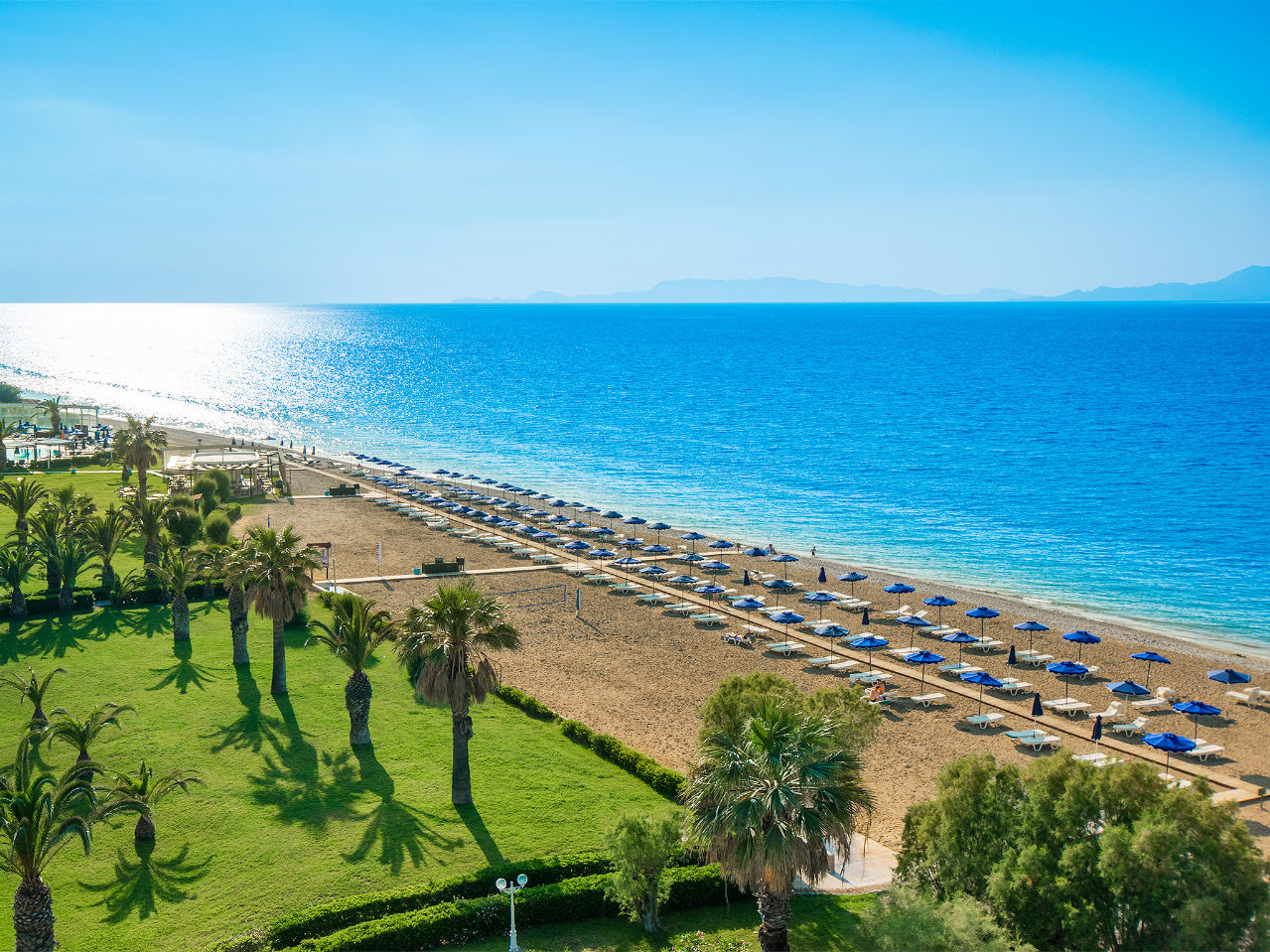
With the “Blue Flag” waving on most beaches and organized shores of the island, Rhodes is awarded every year with the most “blue flags” from many other tourist destinations in Greece. In 2023 Rhodes has been awarded 57 blue flags. It should be noted that this year our country occupies the 2nd place in the world in this issue. The institution “Blue Flag” is part of an international program coordinated by the Hellenic Society for the Protection of Nature (EEPF). It is an internationally recognized symbol of environmental quality, which since 1987 has been awarded to all coasts and marinas that meet its strict requirements. A coast must have the required excellent quality of bathing water and in addition meet the 33 strict criteria relating to cleanliness, organization, information, safety of bathers and visitors, protection of the natural wealth of the coast and coastal and at the same time environmental awareness.
Rhodes- Blue Flags 2023
Αquarium -1 / Statue of Diagoras Αquarium-2 /-Grand Hotel Αquarium -3/ Elli Αquarium -4/ Casino Kavourakia Kavourakia/ Ella Resorts Kallithea Reni Reni 1/Sunwing Kallithea Beach Ammoudes Faliraki/Mitsis Alila Resort Ammoudes Faliraki /Elysium Resort Ammoudes Faliraki /Rodos Palladium Faliraki 1/Esperides Faliraki 2/Amada Colossos Faliraki 3/Esperos Palace Faliraki 4/Calypso Faliraki 5/Blue Sea Faliraki 5/Epsilon Faliraki A Faliraki- Limanaki Faliraki –Kastraki /Grecotel Lux Me Dama Dama Kathara Mantomata Antony Queen Ladiko Traounou Afandou 2/Irene Palace Afandou Afandou 2/ Port Royal Kolympia A- Limanaki/Atlantica Imperial Kolympia/Mythos Beach Kolympia /Mikri Poli Tsampika Tsampika- Symiaki Stegna /Porto Angeli Lardos-1/Lindos Princess Beach Lardos 3/Lindian Village Reni Kalathos/Atrium Palace Vliha/Lindos Mare & Lindos Blu Megali Gi /Atlantica Dreams Resort Megalos Gialos /Lindos Mikros Gialos- Lindos Psaltos/Mitsis Lindos Memories Resort Pefkoi-Li Galouni Kokkinogia Boutique 5 Hotel Galouni Kokkinogia /Mayia Exclusive Resort Galouni Kokkinogia /Mitsis Rodos Village Galouni Kokkinogia /Princess Adriana Resort Kiotari Kiotari- Rodos Princess Beach Kiotari- Aggeliena 1 Kiotari- Aggeliena 2 Lahania /Atrium Prestige Plimmiri /Tui Magic Life Plimmiri by Atlantic Ixia/The Ixian Grand Ixia /Rhodes Βay Ηotel Trianda Β/Sun Beach Resort Trianda /Electra Palace Resort Theologos
Click here to see our magnificent beaches.
The luxury hotels that have facilities and equipment for various forms of activities for children, the city with numerous parks and beautiful beaches with sand and shallow waters and the possibility for any kind of athletic activity (water skiing, windsurfing, parasailing and others) throughout the island, create a picture of a dream holiday for families.
In Rhodes, the young visitors have the opportunity to experience significant cultural experiences such as festivals, concerts, theaters, tours of the Medieval City, cultural and sporting events.
A visit to the Water Park, the Valley of the Butterflies, the Aquarium, Rodini Park with peacocks and Rhodian Deer Platoni, the Luna Park in Faliraki, Aktaion with open playground, the Park of the Democracy and all the playgrounds and parks of the island enrich children’s activities by making the trip a memorable experience.
Rhodes has a high quality tourism product, with high class service, providing security, making it ideal for family holidays.
Ostrich Farm https://farma-rhodes.com/en/ It gives young visitors the opportunity to experience the wonderful world of the animal kingdom. It hosts numerous rare birds and animals
Go Karts in Lardos and Tsairi
- Lardos: +30 22440 44510
- Tsairi: +30 22410 86531 , +30 6944 478793
9D Cinema THRONE OF HELIOS
www.throneofhelios.com 25th of March str., Rhodes (next to Starbucks) +30 22410 76850
3D picture, sound, motion, rain, snow, wind, fire and even smells, placing the service of the senses and entertainment. Throne of Helios offers a fantastic journey in the mythology and the history of Rhodes following the Chariot of the ancient Greek God of Sun, Helios! Apollo, Zeus and the other ancient Greek gods, the Colossus of Rhodes, the Knights of the order of st. John, the Ottoman fleet led by Suleiman the Magnificent, the earthquake that shook the ancient world.
Pallas Cinema
Hipparchos Observatory of Rhodes
http://astrohipparchos.blogspot.gr/
Our idea is astrotourism. The scenic location that the “Hipparchos” Οbservatory is housed, offers at its guests the privilege of tranquility close to nature and breathtaking scenery. The guest has the opportunity to live an experience of observational Astronomy with our instruments of “Hipparchus” observatory, observing the moon, planets, nebulae, galaxies, and many other astronomical objects of the starry sky. Made with care in our star-garden the guest can observe uranography, even find out how a live sundial works and see a static geographical compass orientation, and much more…
THE CULTURAL AND GEOLOGICAL MUSEUM “MELATHRON”
www.cultureandgeology.blogspot.com
- The Cultural (groundfloor) decorated with marble mosaics, wonderful paintings on the ceiling depicting themes from ancient greek Mythology. The classical furniture and gold plated maiandros (fret work) add to its beauty.
- The Folklore (first floor) is full of traditional household utensils, paintings, Rodian pottery and costumes etc.
- The Geological and Mineral exhibit (basement) with 35 showcases of minerals, fossils, volcano and rare rocks and a lot of embalmed fish(200) and animals). The cultural and geological Center of Rhodes has been awarded by UNESCO, The Kapodistrian University of Athens, THE EUROPEAN SOCIETY of SCIENTISTS ARTISTS and WRITERS etc.
- Salakos – Monastery of Prophet Elias
- The Valley of the Butterflies (Museum of Natural History – Holy Monastery Kalopetra)
- Holy Monastery of Panagia Tsambika
- Coastal path Rhodes – Kritika (Kato Petres)
- Ascent to Attaviros
- Archaeological site of the medieval moat
- Walk of the walls
- Ancient Acropolis of Rhodes
- Hill Filerimos in Ialyssos
- Kallithea Springs
- Seven Springs
- Apolakkia bay
1. Salakos – Monastery of Prophet Elias
2. The Valley of the Butterflies (Museum of Natural History – Holy Monastery Kalopetra)
3. Holy Monastery of Panagia Tsambika
4. Coastal path Rhodes – Kritika (Kato Petres)
5. Ascent to Attaviros
The most popular route starts from the south of village of Embona. There are two alternative pathways that can become circular. The most western one, easier but not marked, starts from a small dirt road next to a shrine, into a ravine, goes to southwest direction and then climbs over a rocky ridge. One goes on the dirt road leading to the wind turbines and follows up after the big turning point. From this point the trail has red marks. One follows back uphill, then downhill, meets the asphalt road leading to the radar on the peak and ends up climbing the ruins of the temple of Jupiter known as Jupiter of Attaviros on the side of the highest peak that is not accessible.
The second route starts from the end of the dirt road (fence and steps) initially moves to the side of a stream (a few red marks) and then without a path, either straight up a steep field or a curvy path that leads to a small valley below the top.
It is possible to make the ascent from the north edge of the village of Agios Isidoros there is a marked path to the wind turbines that comes and goes as above. Whatever route you follow ones should be equipped with the necessary clothes because even in summer the temperature difference is large and there is always a possibility of a fog. Also there is no well or source of water supply. The physiology of the soil is mostly rock and sand.
6. Archaeological site of the medieval moat
- From the port of Mandraki (behind the main taxi rank)
- Gate Akantias
- From the Kanonia Gate after Ag. Antoniou Gate
7. Walk of the walls
It offers a view of world heritage city, sacred and inspiring because thousands of young people fell in towns and sieges of Rhodes painting the walls with their blood.
The entry price and the timetable are set out by the Archaeological Service depending on the needs of each period.
8. Ancient Acropolis of Rhodes
9. Hill Filerimos in Ialyssos
10. Kallithea Springs
11. Seven Springs
Rhodes has a long history in sports. Already from the first Olympic Games of antiquity many Rhodians excelled, famous athletes, such as Olympic champion Diagoras and many of his family members such as Leonidas of Rhodes.
Rhodes now has the facilities and the expertise to host and support major sport events but also the preparation, coaching teams and individual athletes in each category in many sports, whereas now there are: track and field 400 meters and 8 lanes, modern Olympic sailing, laser, indoor halls with wooden flooring, tennis courts with green set, archery facility with modern equipment including chronometer, football fields with natural grass or artificial turf, table tennis equipment, modern clay target shooting and other expertise for the organization of major events.
If you add the ideal weather conditions, the idyllic natural environment, history and culture of the island and the high standard of accommodation with excellent hotel amenities, it is obvious that Rhodes is the perfect place to host major sporting events, but also the preparation and the coaching sport teams and individual athletes.
Strong winds and wavy water conditions makes this the perfect spot for freestylers, racers and Kite surfers. Take this opportunity to learn windsurfing in Rhodes, one of the best windsurfing locations in Europe.

Water bikes and canoes for rent are available in almost all of the locations.
For More Information
ΣΥ . ΦΙ . ΘΑ . ΣΠ . ΡΟ . ( Association of Friends of Water Sports Rhodes)
Iraklidon Avenue 85101 Ialissos Rhodes +302241024995 +306981872220 [email protected]

Enjoy the richness of our underwater world. As pioneers of this type of leisure in Greece, we give you the opportunity for an exceptional experience. The diving training centers provide you with all the guarantees for a pleasant dive, observing all the standards required for your safety. You will be amazed at how easy it actually is.
Our international teams are fully trained. Using the latest technology in their equipment they can really make your diving unique. Diving boats depart daily from the port of Mandraki.
Diving Centers in Rhodes
Rodos Diving Center
Mandraki Rhodes +306944735736, +302241020207 [email protected]
Scuba Diving Trident School
Mandraki Rhodes +306944368444, +302241029160 www.tridentdivingschool.com [email protected]
The Water Hoppers
Mandraki Rhodes +306932963173, +302241038146 www.waterhoppers.com [email protected]
Sailing and windsurfing

The facilities include:
- Equipment including available Laser STD, RDL and 4,7 boats acquired in 2007 and RS: X Neil Pryde surfboards.
- For the Laser track with calm waters at a short distance from the installation on the east side of the island.
- Locker rooms, showers, WC, gym, storage areas, boat repair staff and ramp to enter the water.
- Meeting rooms with telephone and internet.
- Racing pool 25 meters, 8 routes.

The fairs of Rhodes are mostly focused on the religious element and tied with religious celebrations. Since the ancient times the Greeks liked to spice up their lives with fairs and festivals.
The fairs in the villages and towns are divided on three parts:
- First the religious, with the church service and procession of the icon.
- Second the entertainment, music and dancing.
- Third the commercial, outdoor bazaars. As in the past at the fairs, people have the opportunity to meet each other, friends and relatives and purchase many items from the bazaars.
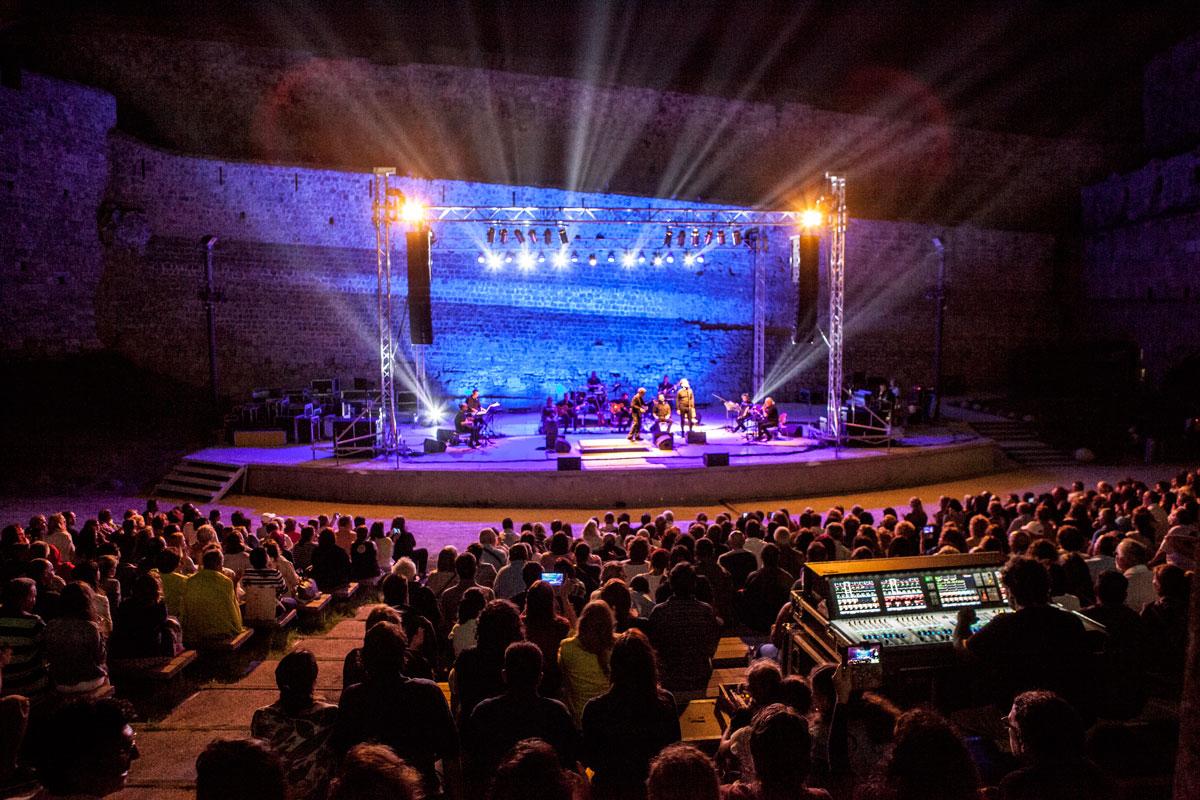
The New Market
With extremely pleasant walk in our market, where the flavors of the sea are mixed magically with jasmine and night flower, one discovers prestigious international brand products (hand made jewellery – silver and gold, luxury clothing, footwear, cosmetics, household items).
It is noteworthy that our market has 40 years tradition in luxury items with strong brand names, while fashionable coffee-shops provide relaxation during the day and night.
We should also refer to the products of pottery, one of the oldest art forms of the origin of Aegean islands, are found in souvenirs shops as also the handmade leather sandals made by the artisans on the island.
Commercial Stores
Winter Store Hours Monday- Tuesday- Thursday- Friday: 09.30-13.30 and 17:00-21:00 Wednesday- Saturday: 09.30-17.30
Winter Sales Period 16/01 until 28/02
Spring Store Hours from 01/04 Monday- Tuesday- Thursday- Friday: Free Opening Hours Wednesday- Saturday: 09.30-20:00
Summer Sales Period 15/07 until 31/08
The local products
FOOD AND DRINΚS
One encounters in some of the eating habits of the Rhodians in many Mediterranean regions such as Asia Minor and southern Italy, reflecting the ancient family ties and contacts Rhodes had with them. The cuisine was not only used for the satisfaction of biological needs but to strengthen socio-cultural relations with different people and groups.
Some food has initiatory or religious character, such as recipes for meat, fish and sweets that surround engagements,weddings, baptism and religious holidays such as Easter, Christmas and the Assumption (15th of August).
Today Rhodian culinary delights are based on the delicacies of the sea, salads created by new products such as avocado, arugula and tarragon grown on the island and cooked meats with new modern recipes.
Food, Sweets and Beverages – What to Try
People with disabilities – Information for accessible tourism in Rhodes
http://www.accessible-rhodes.com https://www.wonderaccess.com Brochure on accessible tourism
ASKLIPEIADES
The Social Cooperative Enterprise “ASKLIPEIADES” in collaboration with the Association of People with Disabilities of the District of Rhodes, is active in the field of providing services to vulnerable social groups in order to improve their quality of life, their integration and the elimination of social exclusion, as well as to provide support and counseling to families.
Services of “ASKLIPEIADES”
- Equipment rental
- Transportation services
- Accessible spaces
Information:
Social Cooperative “ASKLIPEIADES” Association of People with Disabilities
Errikou Schliemann 1, Rhodes, P.C. 85100 +32241063660 | +302241072571
www.pwdservices.gr [email protected] http://facebook.com/pwdservices.gr
Access infrastructure to the beaches of Rhodes
The action “Creation of non-permanent infrastructure for access to the beaches of the Municipality of Rhodes” concerns the supply of non-permanent, specialized and innovative systems, in the context of an integrated intervention that will contribute to the development of tourism and the accessibility of visitors with disabilities to the beaches of the Municipality of Rhodes. The intervention takes place in the following crowded and organized beaches of the Municipality:
- Faliraki Beach
- Afandou Beach
- Lindos Beach
In particular, the operation includes the supply and installation of the following systems:
- Guidance device at sea and on the shore of visually impaired people at Lindos Beach. This provision enables visually impaired people to enter the sea, swim freely and safely and return to shore without the need for assistance from another person. It informs the user about his geographical location during swimming, his distance from the beach, the depth of the water, etc.
- Provision of autonomous access to the Sea for People with Mobility Problems at the beaches of Elli, Faliraki and Afandou. With this provision, people facing mobility difficulty will enter/exit the sea safely and without the assistance of an escort.
- Necessary auxiliary equipment for the use of the above beaches by people with disabilities and specifically toilets/changing rooms for disabled people, access corridors, shading areas, umbrellas and information signs.
Under construction …
The winners are thrilled by the island’s natural beauties, culture and many attractions but also of the local’s hospitality and reinstate their intentions of re-visiting the island the coming years. According to them, Rhodes is a safe and beautiful tourist destination, a message that by their return home, is conveyed to friends, travel agencies, the mass media and even their parliament. Throughout the years, friendships have been grown and they consider the award a great honour and distinction.
It is a fact that these people are considered Goodwill Ambassadors for Greece in these times of difficulty for the country. Their insistence of visiting Rhodes, and this despite of an unfavorable image formed by foreign media for Greece, greatly contributes to the restoration of the true image of Greece. Their years of presence on the island, consolidate bridges of culture and cooperation and create priceless bonds of friendship between people.
Visitors that qualify for the “Repeaters” awarding programme please fill in this form and send it to us
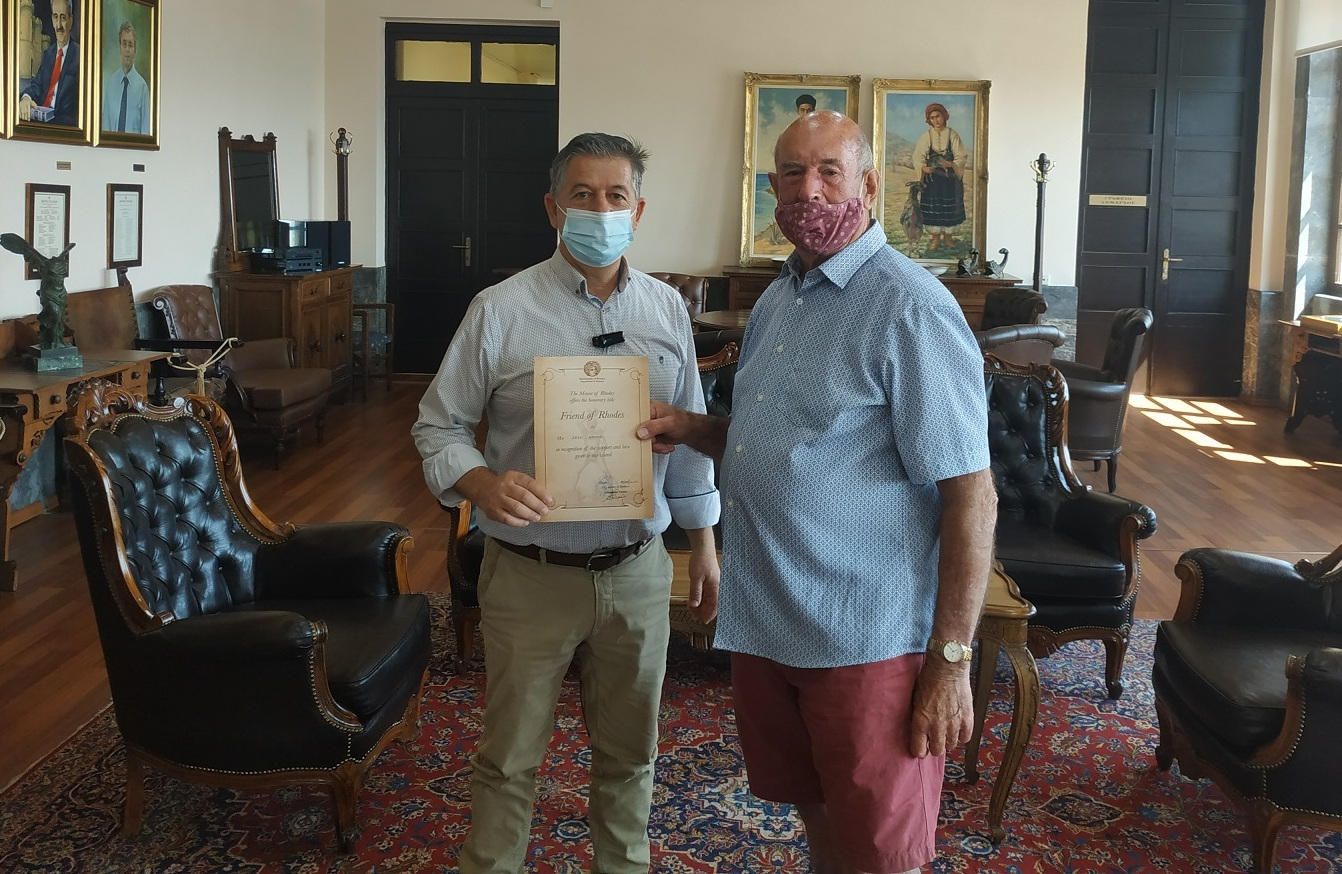
Leonardo Lifelong Learning – So.To Programme
Memorial Service for Victims 22nd of July 2011 in Norway
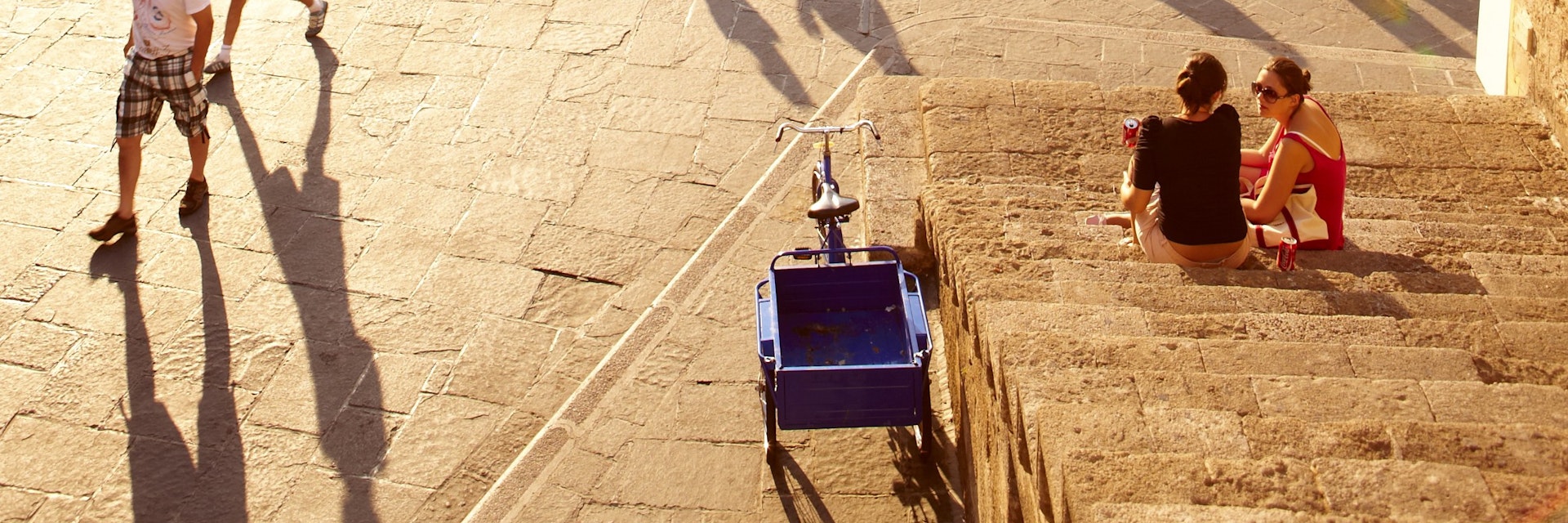
By far the largest and historically the most important of the Dodecanese islands, Rhodes (ro-dos) abounds in beaches, wooded valleys and ancient history. Whether you’re here on a culture-vulture journey through past civilisations, or simply for some laidback beach time, buzzing nightlife, or diving in crystal-clear waters, it’s all here. The atmospheric Old Town of Rhodes is a maze of cobbled streets that will spirit you back to the days of the Byzantine Empire and beyond. Further south, in the picture-perfect town of Lindos, capped by an ancient Acropolis, sugar-cube houses spill down to a turquoise bay. While both Lindos and Rhodes Old Town get very crowded in summer, Rhodes is large enough to allow plenty of room to breathe that pure Aegean air.
Leave the planning to a local expert
Experience the real Rhodes. Let a local expert handle the planning for you.
Attractions
Must-see attractions.
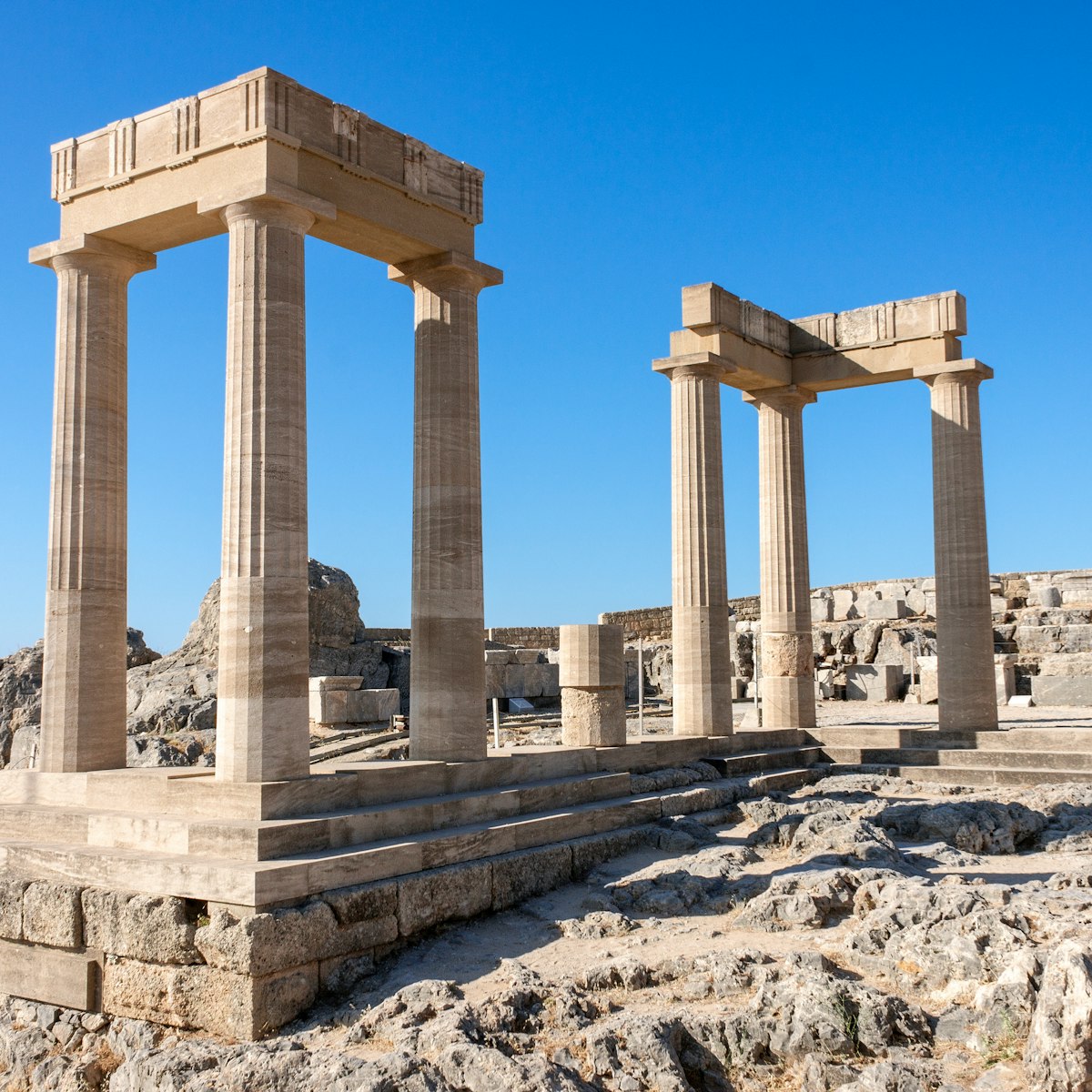
Acropolis of Lindos
A short, steep-stepped footpath climbs the rocky 116m-high headland above the village to reach Lindos’ beautifully preserved Acropolis. First fortified in…
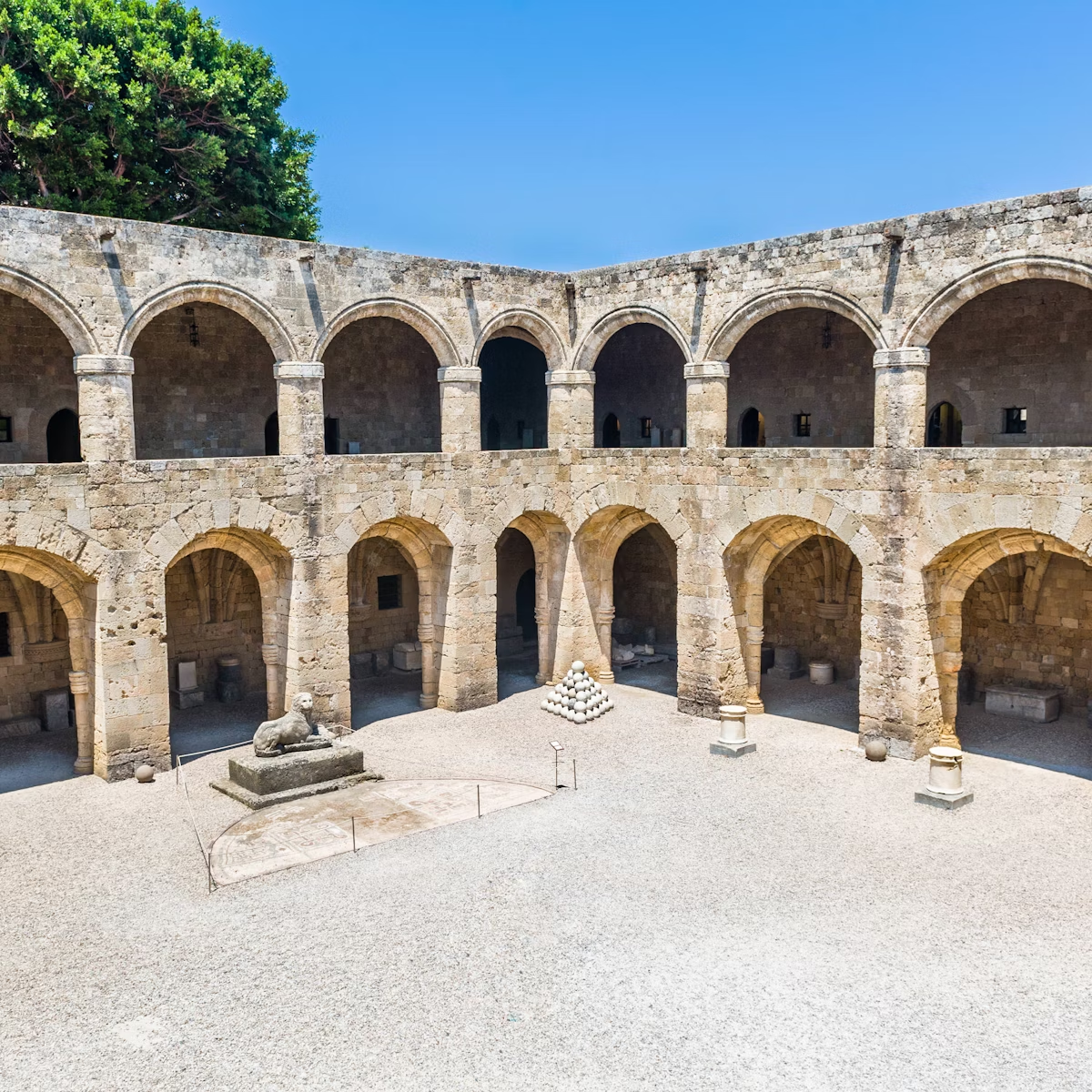
Archaeological Museum
Rhodes Town
A weathered, sun-kissed stone lion, visible from the street, invites visitors into the magnificent 15th-century Knights' Hospital that holds Rhodes’…
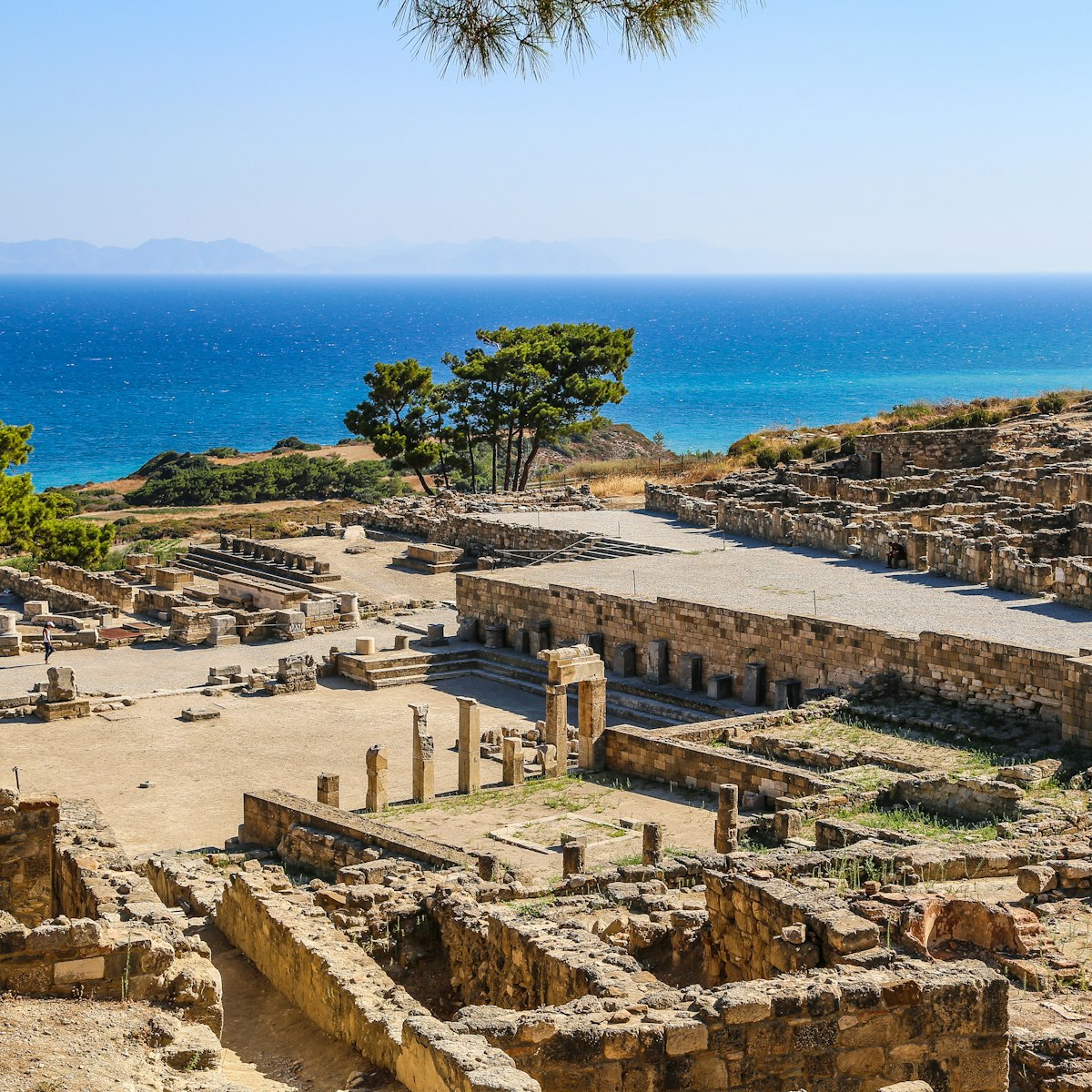
Ancient Kamiros
Cradled in a natural hillside amphitheatre 1km up from the sea, the remarkably complete ruins of ancient Kamiros stand 34km southwest of Rhodes Town…
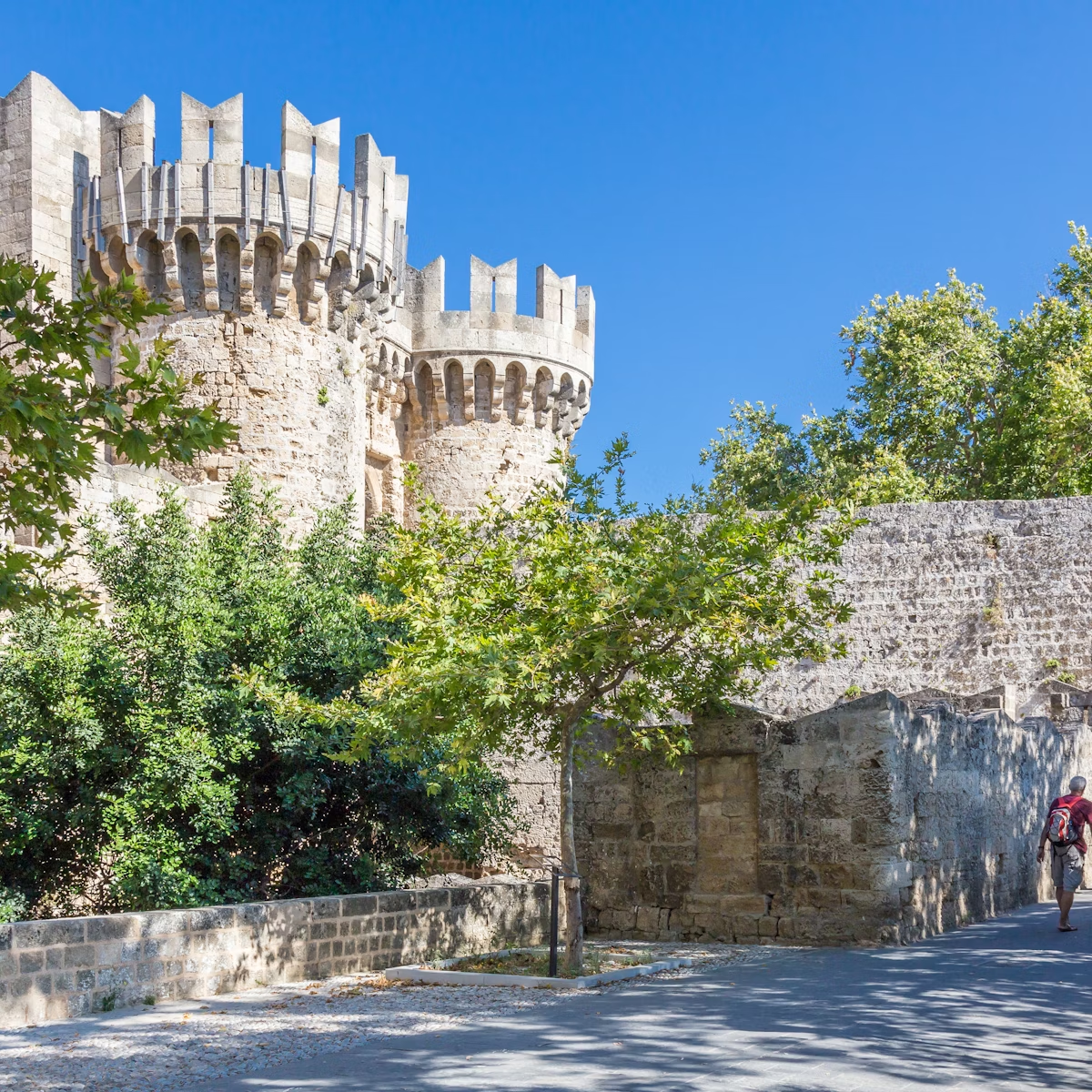
Knights’ Quarter
Essentially an occupying army, the Knights of St John transformed the northern segment of the Old Town during the 14th and 15th centuries, to create what…

Palace of the Grand Master
From the outside, this magnificent castle-like palace looks much as it did when erected by the 14th-century Knights Hospitaller. During the 19th century,…
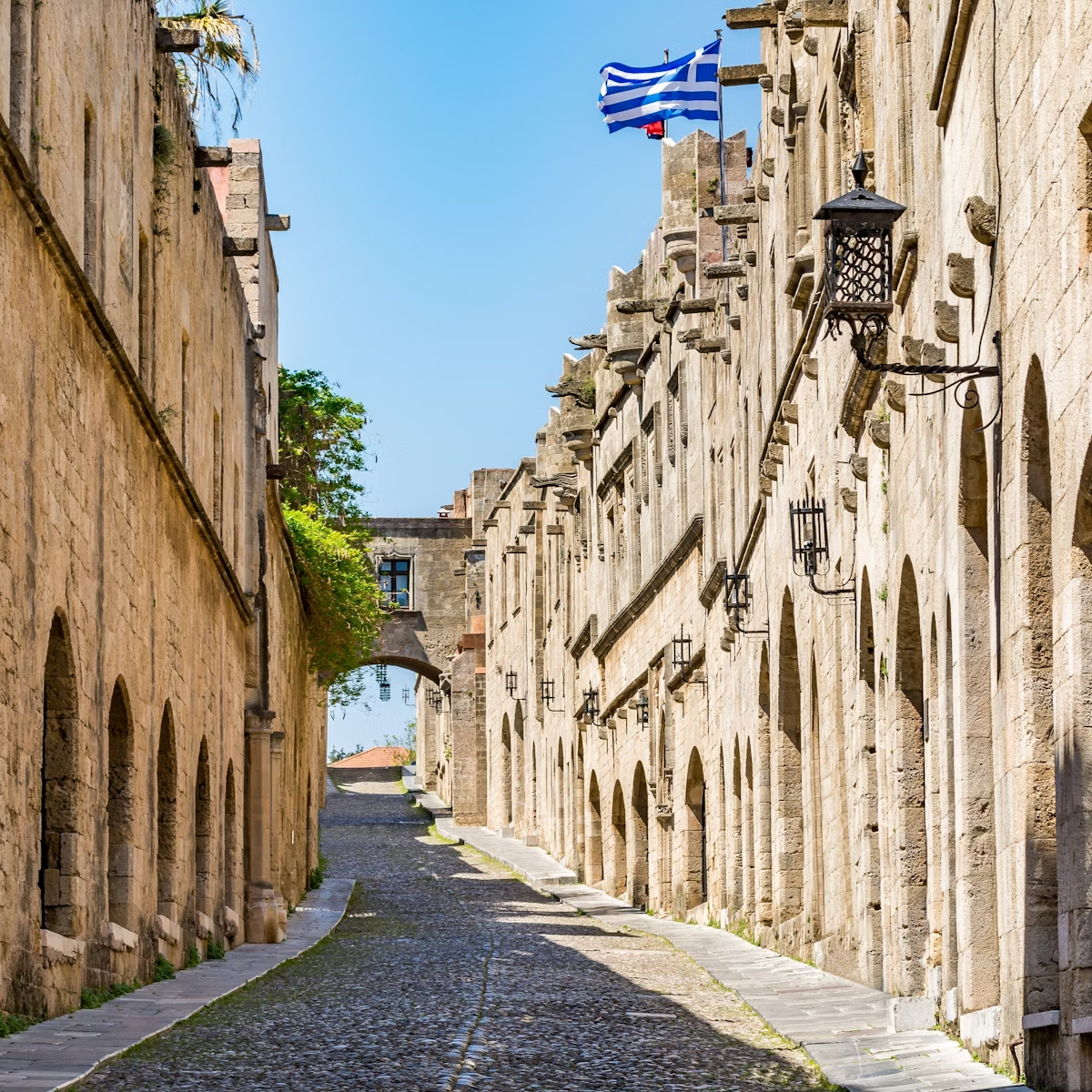
Street of the Knights
Austere and somewhat forbidding, the Street of the Knights (Ippoton) was home from the 14th century to the Knights Hospitaller who ruled Rhodes. The…
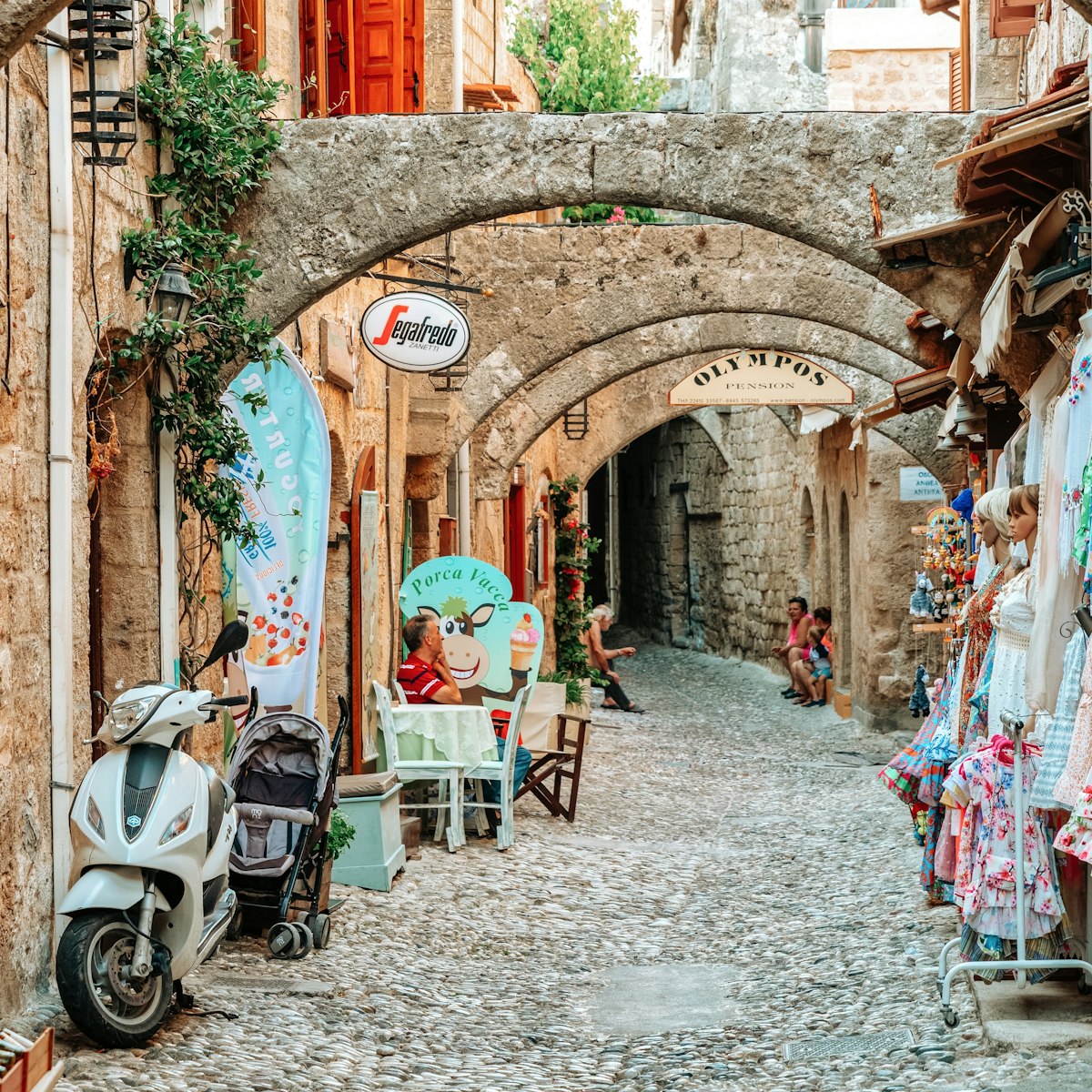
The Old Town’s central commercial and residential district, south of the Street of the Knights, is known as the Hora. Having acquired its current…

Valley of the Butterflies
The so-called Valley of the Butterflies, 7km up from the west coast, and 32km southwest of Rhodes Town, is a major day-trip destination for package…
Plan with a local
Experience the real Greece
Let a local expert craft your dream trip.
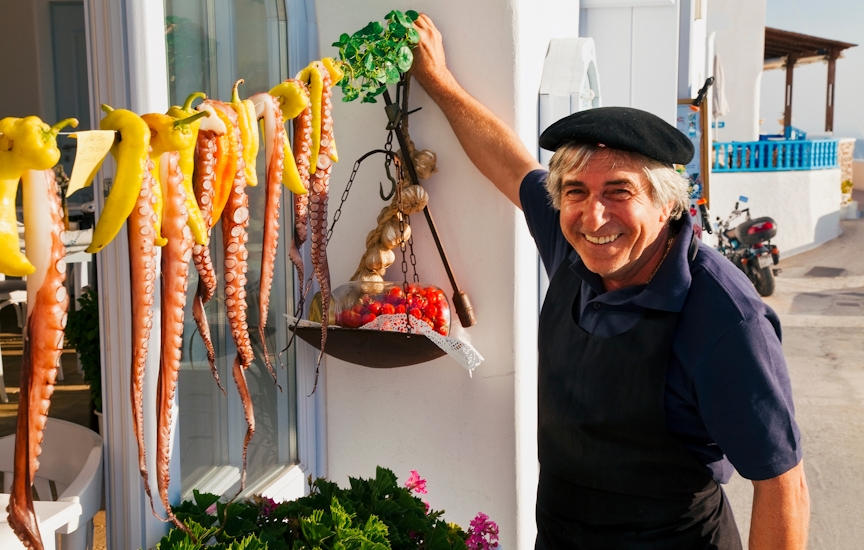
Latest stories from Rhodes
Filter by interest:
- All Interests
- Adventure Travel
- Art & Culture
- Beaches, Coasts & Islands
- Food & Drink
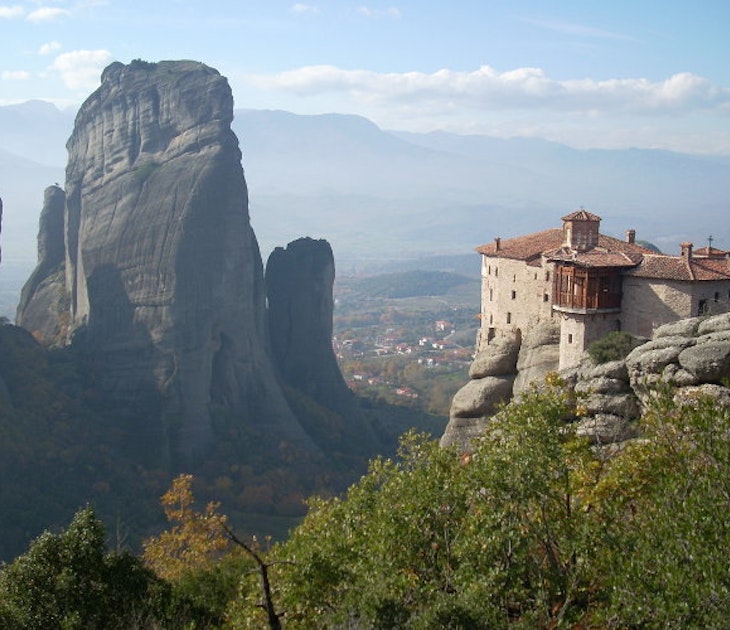
Oct 29, 2019 • 5 min read
Greece in winter is a land of glorious walks, uncluttered ancient sites and bustling city life. Here are the top things to do in Greece in winter.

Oct 4, 2019 • 6 min read
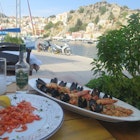
Feb 14, 2019 • 7 min read

Feb 20, 2015 • 6 min read
in partnership with getyourguide
Book popular activities in Rhodes
Purchase our award-winning guidebooks.
Get to the heart of Rhodes with one of our in-depth, award-winning guidebooks, covering maps, itineraries, and expert guidance.
Rhodes and beyond
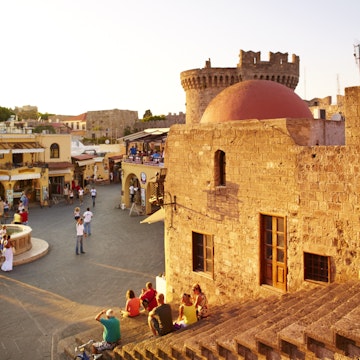
RHODES, GREECE
Lindos, the most charming village of Rhodes
The impressive Palace of the Grand Masters
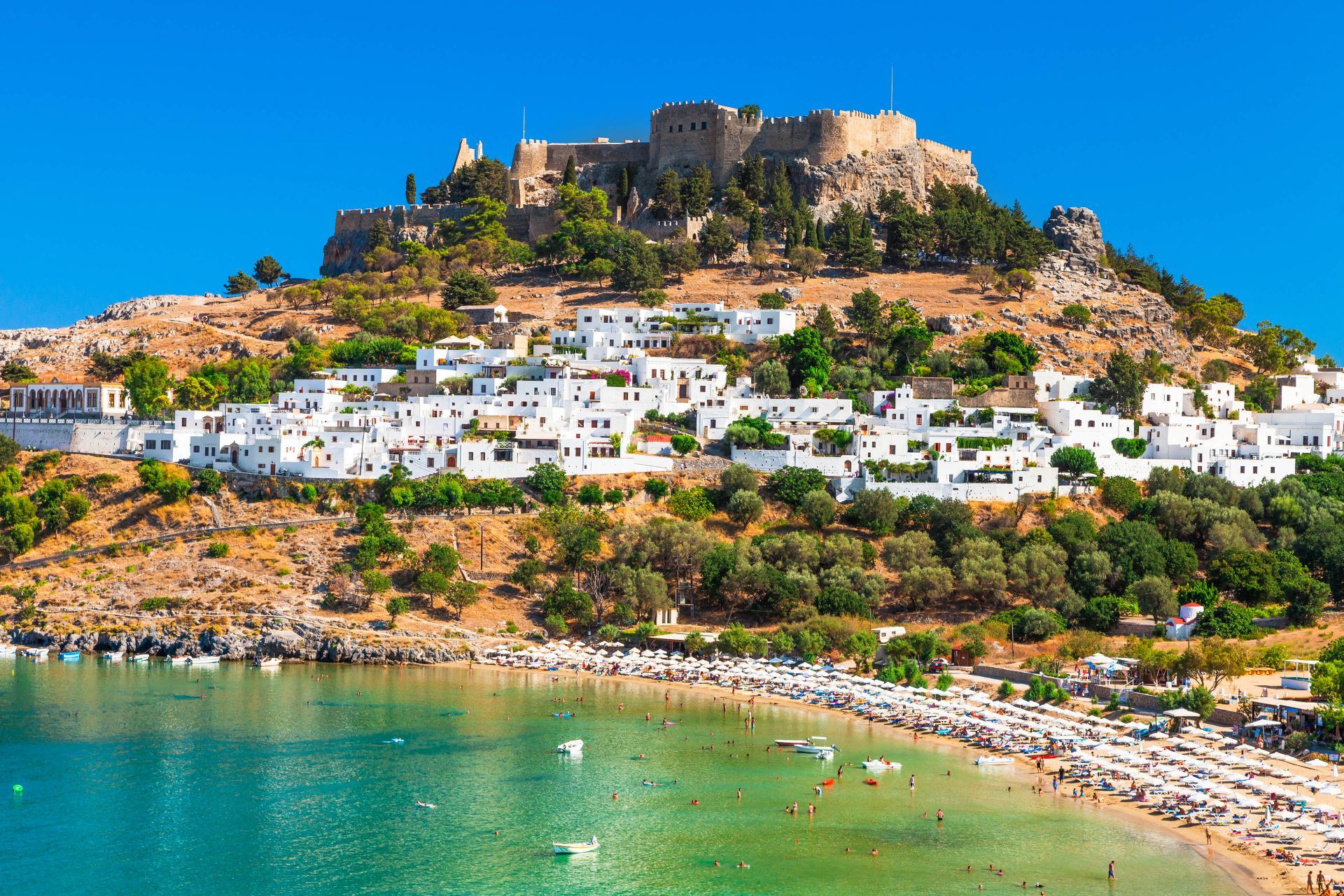
The beautiful beach of Lindos - Agios Pavlos
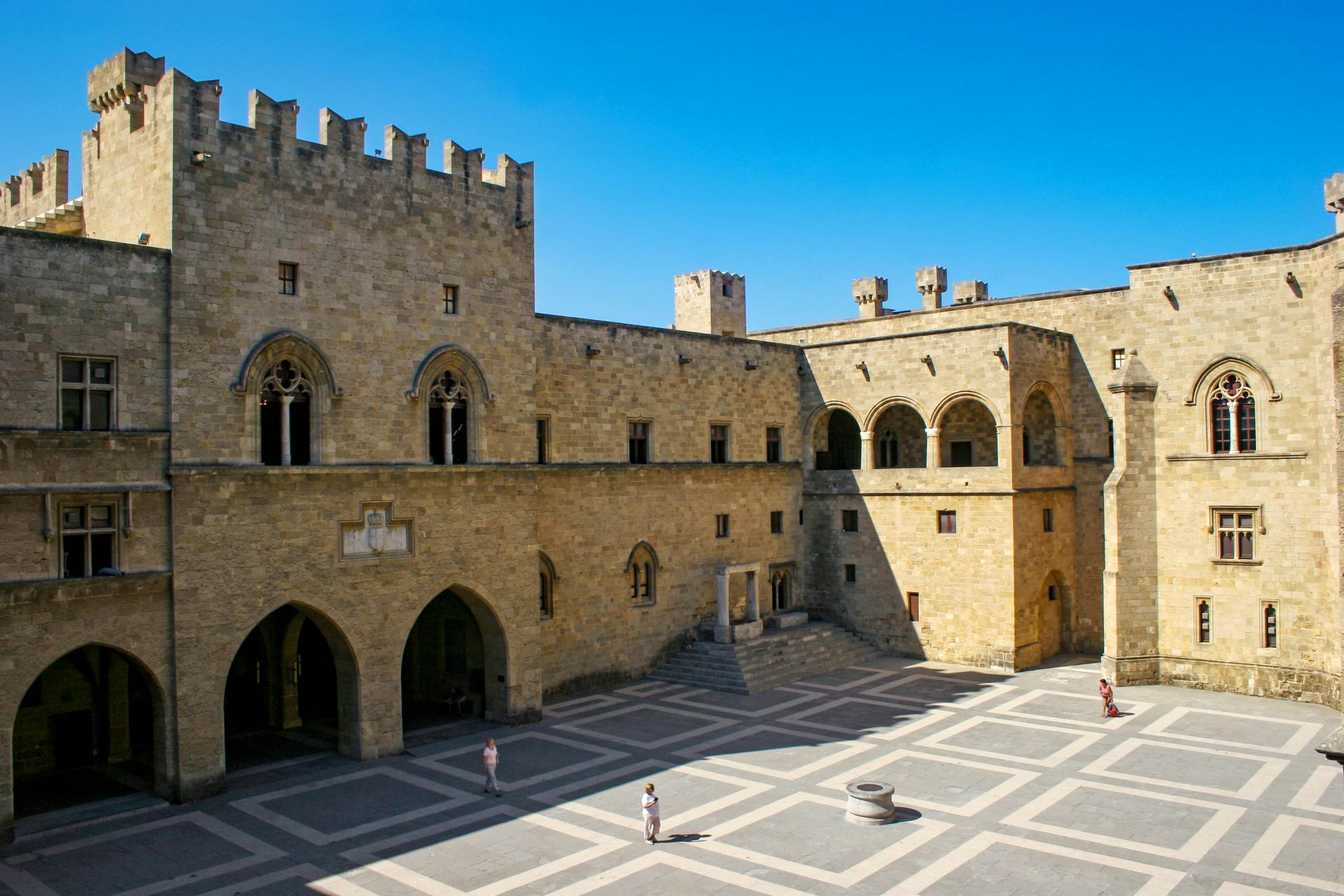
TRENDING IN RHODES
How to get there?
Things to Do
Our selection of restaurants
Island-hopping package, from 594€

TRAVEL GUIDE TO RHODES
Also known as the "Knights’ island", Rhodes combines a rich history, impressive medieval architecture, amazing beaches and a lovely natural scenery! The Old Town of Rhodes with its stone-paved alleys and elegant mansions is a listed World Heritage Site.
Find out everything about your holidays in Rhodes on our travel guide! Discover the best things to do, fantastic beaches , landmarks, top hotels and restaurants , as well as a wide selection of breathtaking photos !
You can reach the island by plane from Athens or abroad or by ferry from Athens, Crete or other islands of the Dodecanese.
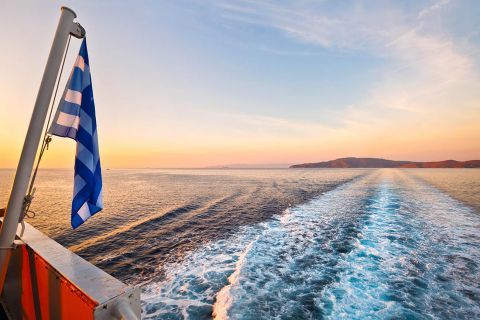
Best Hotels
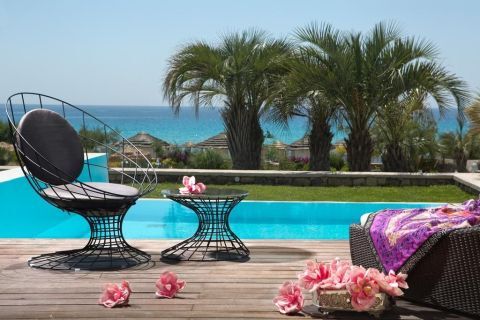
Things To Do (13)
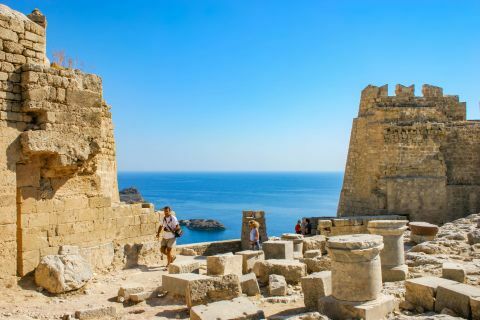
Where to swim?
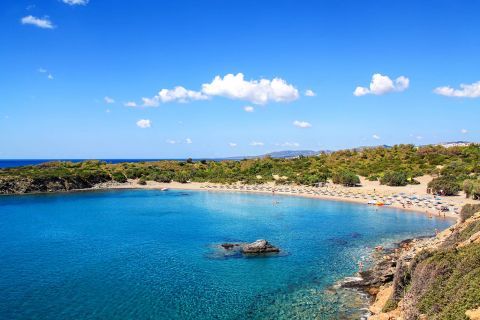
Sights & Attractions
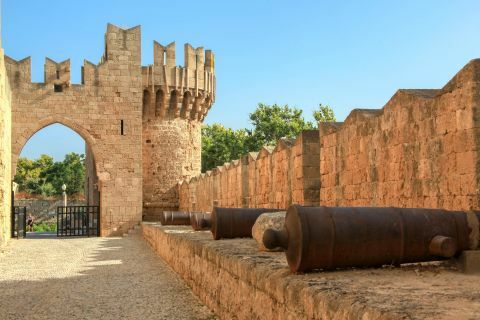
Where to Eat & Drink?
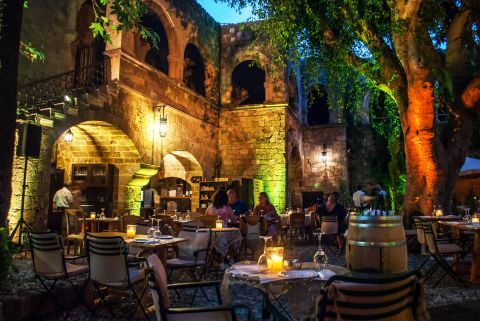
OUR TRAVEL SERVICES IN RHODES
We help thousands of people every year to plan beautiful and trouble-free holidays in Greece. From hotels to ferry tickets, we provide all the essential travel services, to make your trip to Greece the most epic and smooth one. Our services are rated . Our guide and services won the Silver Award (2020) of the annual Tourism Awards in Greece . Read reviews about our services.
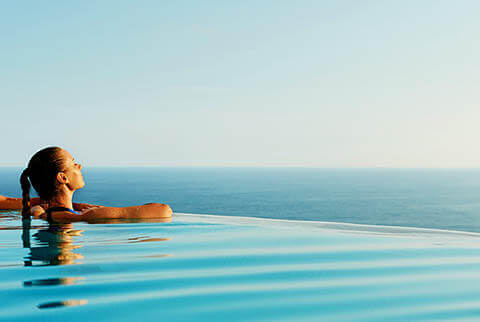
MORE ABOUT RHODES GREECE
Rhodes combines cosmopolitan vibes with medieval architecture in a unique way! The natural landscape, imposing buildings, ancient towns and picturesque villages meet amazing beaches, fashion boutiques, top restaurants, and dance clubs. No wonder why it never fails to surprise travelers from all over the world!
The most important monuments of the island can be seen in the Old Town . The Old Town is a Unesco World Heritage Site and one of the best-preserved medieval towns in Europe, attracting millions of visitors every year! Stroll around the paved alleys, visit the Venetian Castle , the Street of the Knights and the Palace of the Grand Master . The atmosphere will captivate you! Apart from exploring the Old Town, there are so many things to do on the island! Visit the imposing Acropolis of Lindos, the Valley of butterflies, the monastery of Filerimos, do water sports and tours . The adventure never stops in Rhodes! As for its beaches , they are some of the best beaches in Greece! Secluded or crowded, cosmopolitan or hidden, there’s no way you won’t find the perfect beach for you. Lindos, Anthony Quinn, Faliraki, Tsambika, Kallithea and Agathi are some of the best beaches on the island!
Get ready to create some amazing memories in Rhodes! Stroll around the historical town, visit its medieval monuments, discover imposing castles, eat at excellent restaurants and swim at its amazing beaches. Rhodes always offers something new to discover!
PHOTOS OF RHODES / SHARE YOUR EXPERIENCES
Explore Rhodes island through the lens of the talented members on Greeka community . Share your experience with us or tag us #greekacom on your favorite social media.
HOTELS & ACCOMMODATIONS
As one of the most popular destinations of the Dodecanese, the well-developed island of Rhodes offers a wide variety of hotels of all kinds, from small and charming boutique hotels to big all-inclusive resorts near the beach, with swimming pools and other facilities. Some of the most popular hotels are Melenos Lindos , F Charm , Princess Andriana & Labranda Kiotari Miraluna . Besides Town, other locations that offer many accommodation options are Ialissos, Lindos, Ixia and Faliraki.
HOW TO GET TO RHODES?
The island of Rhodes has an international airport with flights from Athens and many European cities. You can also reach the island by ferry from the port of Piraeus in Athens but also from other islands of the Aegean. Book your ferry tickets with us !
Discover the different ways to get there and move around:
HIGHLIGHTS: BEST OF RHODES
Discover the best of Rhodes! From sightseeing to activities and from tours to restaurants, we give you the best recommendations for the ultimate holiday experience!
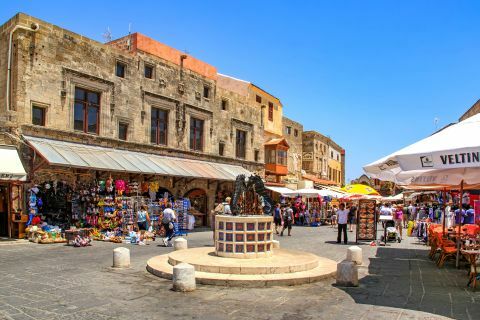
OUR RHODES HOLIDAY PACKAGES
Discover the best island hopping packages, tours and travel packages!
WHERE TO GO NEXT?
Continue your trip to the best Greece destinations!
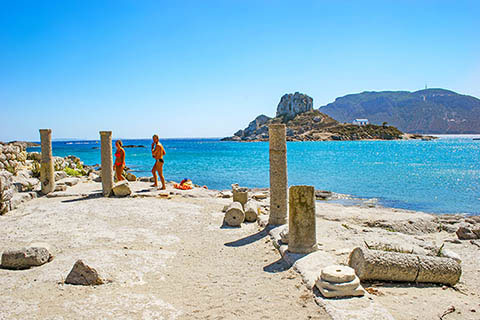
- Share this page on Facebook
- Share this page on Twitter
- Copy the URL of this page
Sign in to the Greeka Community.
Upload your best photos of Greece and interact with other Greeka members!
- Introduction to Rhodes
- Quick facts
- The city of Rhodes
- Explore the east coast
- Explore the west coast
- Rhodes history overview
- The Colossus of Rhodes
- Rhodes 2400 years - the exhibition
- Explore & get inspired
- Travel Guide Overview
- Monuments & Historical Sites
- Beaches & resorts
- Nature & places to visit
- Sports & Recreation
- Family travel
- Video gallery
- Live Streaming
- Useful info
- How to get to Rhodes
- Useful contacts & phone numbers
- Weather & climate information
- Vacation tips
- Safety in Rhodes
- Rhodes reviews - your experiences
- Taxi and transportation on Rhodes Island
- Blog & Stories
Welcome to Rhodes
The island of timeless wonders, welcome to rhodes island in greece, a sun-kissed jewel in the southeastern aegean sea where history, nature, and culture come together to create an unforgettable experience, discover beaches, read the latest on our blog from rhodes, discover nature, discover historical sites, discover rhodian villages.
· Complete travel & information guide about Rhodes (Rhodos) island in Greece ·
© 2003 - 2024 Rhodes Island Travel Guide. All Rights Reserved.
Hosted on CO2 Neutral Servers

- Ελληνικά

Please help us improve RhodesGuide.com by answering a few questions

IMAGES
VIDEO